This site uses affiliate links, meaning that if you make a purchase through our links, we may earn an affiliate commission.
Get ready for an adrenaline-pumping ride through Glacier National Park on the iconic Going-to-the-Sun Road!
Discover the 18 best stops on Going-to-the-Sun Road, from majestic peaks to serene lakes. Brace yourself for jaw-dropping vistas, wildlife encounters, and the pure magic of Glacier. Buckle up – the adventure of a lifetime awaits around every bend!
- 1. What Is Going-to-the-Sun Road All About?
- 2. Ever Wondered Why It's Called Going-to-the-Sun Road?
- 3. What Are the Estimated Drive Times on Going-to-the-Sun Road?
- 4. What Is the Best Direction to Drive?
- 5. When's the Best Time to Drive?
- 6. Should You Use the Shuttle, Tour Company, or Drive Your Vehicle?
- 7. Tips for Navigating Going-to-the-Sun Road
- 8. Vehicle Size Restrictions
- 9. Availability of Bathroom Facilities
- 10. Get a Reservation Ticket to Drive on Going-to-the-Sun Road
- 11. What to Bring on Going-to-the-Sun Road?
- 12. Glacier National Park Going-to-the-Sun Road Map
- 13. 18 Best Stops on Going-to-the-Sun Road
-
- 13.1. Lake McDonald - Mile Marker 2
- 13.2. Lake McDonald Falls and Johns Lake Loop Trail - Mile Marker 12
- 13.3. Sacred Dancing Cascade Viewpoint - Mile Marker 13.5
- 13.4. Avalanche Creek and Trail of the Cedars - Mile Marker 16
- 13.5. West Side Tunnel - Mile Marker 23
- 13.6. The Loop - Mile Marker 24
- 13.7. Bird Woman Falls and Haystack Creek Falls - Mile 27 and 28
- 13.8. The Weeping Wall - Mile Marker 29
- 13.9. The Big Bend And the View of the Triple Arches - Mile Marker 30
- 13.10. The Oberlin Bend Overlook - Mile Marker 31
- 13.11. Logan Pass - Mile Marker 32
- 13.12. Lunch Creek - Mile Marker 33
- 13.13. East Tunnel - Mile Marker 34
- 13.14. Siyeh Bend and Siyeh Creek - Mile Marker 35
- 13.15. Jackson Glacier Overlook - Mile Marker 38
- 13.16. St. Mary Falls Trail - Mile Marker 39
- 13.17. Wild Goose Island Lookout - Mile Marker 43
- 13.18. St. Mary Lake and St. Mary Visitor Center - Mile Marker 50
- 14. Intrepid Scout's Tips for Going-to-the-Sun Road in Glacier National Park
What Is Going-to-the-Sun Road All About?
Going-to-the-Sun Road is the stuff of legends, weaving 50 miles through Glacier National Park in Montana. It’s more than a scenic route; it’s an odyssey through North America’s most awe-inspiring landscapes.
Crafted between 1921 and 1932, it’s not just a drive but an adventure. You will traverse the Continental Divide at Logan Pass and relish panoramic views, glacial lakes, dense forests, and alpine meadows.
Beyond the scenic drive, it’s a portal to outdoor escapades – hiking, wildlife encounters, and immersion in Glacier National Park’s pristine beauty await. Ready for a legendary journey?
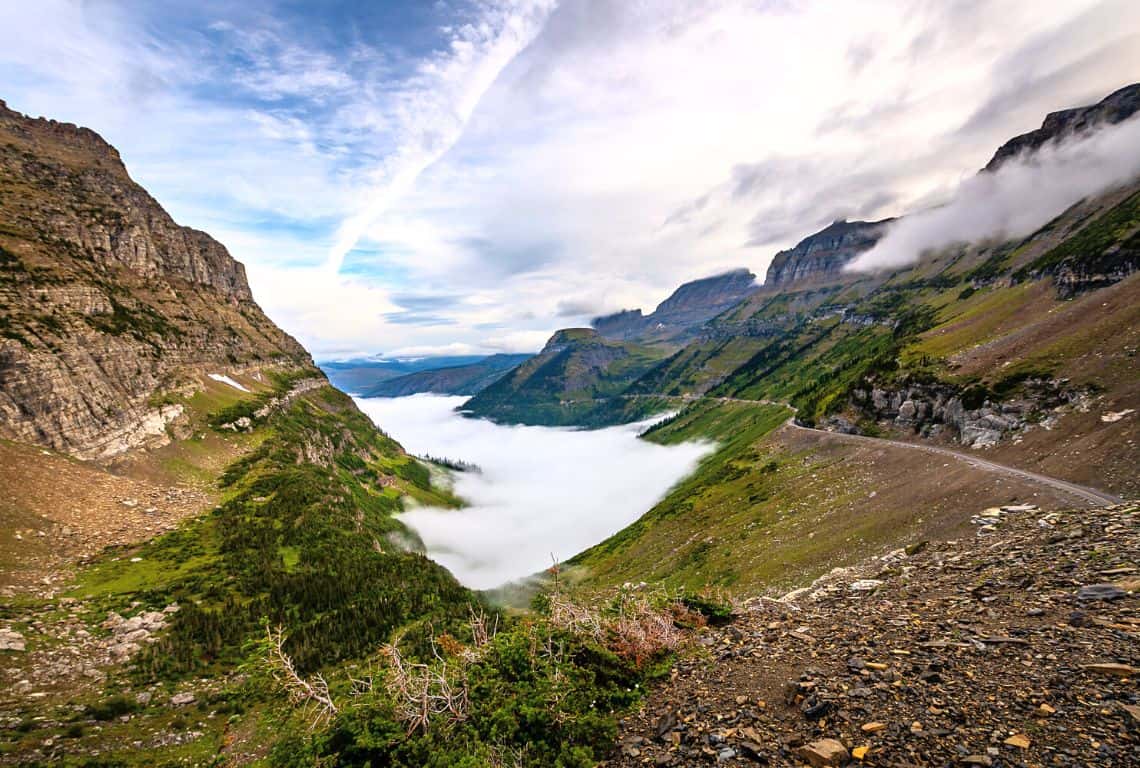
Legendary Going-to-the-Sun Road in Glacier National Park
Ever Wondered Why It's Called Going-to-the-Sun Road?
Going-to-the-Sun Road derived its name from the nearby Going-to-the-Sun Mountain, which holds deep cultural and spiritual significance for the Indigenous people of the region. The name is rooted in legend and folklore, passed down through generations.
According to the Blackfeet Nation, the Going-to-the-Sun Mountain is a sacred place where the Sun God resides. The mountain is believed to be a bridge connecting the earthly realm to the divine.
Inspired by the profound symbolism and reverence associated with this mountain, the road was named Going-to-the-Sun Road as a tribute to the rich cultural heritage and natural wonders of the area.
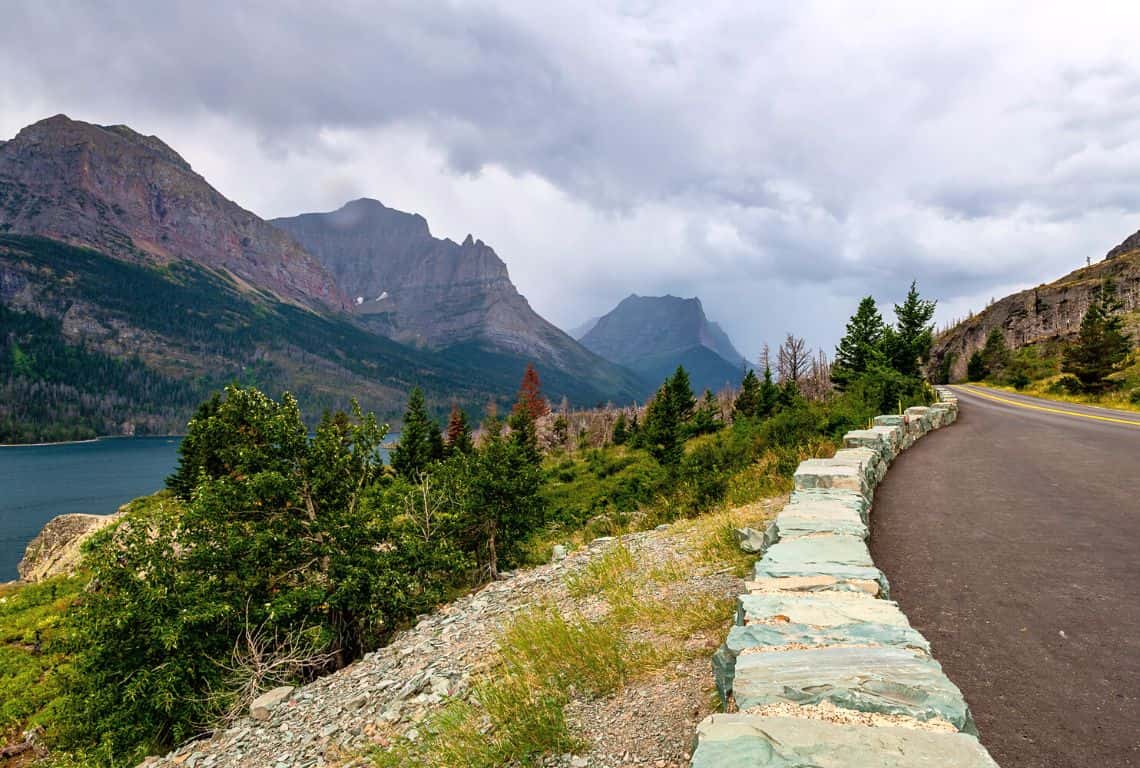
Going-to-the-Sun Road derived its name from the nearby Going-to-the-Sun Mountain
What Are the Estimated Drive Times on Going-to-the-Sun Road?
Driving the entire length of Going-to-the-Sun Road without any stops typically takes around 2 to 2.5 hours. However, it’s important to note that this estimate can vary depending on factors such as traffic, road conditions, and the time of year.
If you plan to make stops along the way to explore the attractions and enjoy the breathtaking scenery, it’s recommended to allocate a minimum of 4 to 6 hours for the journey. This timeframe allows for leisurely stops at some of the major viewpoints, photo opportunities, a couple of short hikes, and a visit to Logan Pass Visitor Center.
GOOD TO KNOW: Glacier National Park is known for its abundant wildlife, so allowing extra time for wildlife sightings and potential traffic delays caused by animal crossings is advisable. It’s essential to drive cautiously and adhere to the speed limits, especially in wildlife-heavy areas.
INTREPID’S PRO TIP: To truly savor the beauty of Going-to-the-Sun Road and make the most of your experience, consider allocating a full day! This will allow time for exploration, longer hikes, and just immersing yourself in the landscapes that this scenic road has to offer.
What Is the Best Direction to Drive?
The Going-to-the-Sun Road spans the width of Glacier National Park between the west entrance (West Glacier) and the east entrance (St.Mary) of the park. So, it runs west to east or vice versa and it is the only road that traverses Glacier National Park.
When driving Going-to-the-Sun Road in Glacier National Park, there isn’t a strict rule regarding which direction to travel. However, some general recommendations can enhance your experience.
- During the peak tourist season (typically from late June to early September), it is often recommended to start your journey from the east side of the park and drive westward. This allows you to take advantage of the early morning hours when the road and parking areas are less crowded. Starting early also increases your chances of finding available parking at popular stops and viewpoints.
- Driving from east to west also offers the advantage of having the sun at your back for most of the drive. This can enhance visibility and minimize any potential glare, making it easier to appreciate the stunning views and capture better photographs.
- My recommendation is to drive the Going-to-the-Sun Road from west to east. You will be driving on the outer edge of the road through the portions that are carved into the side of the mountains, making the views even more spectacular and with easier access to pull-offs.
- If you do not tolerate high elevations well, or just driving on the outer edge of the road is not your thing, then my suggestion is to drive the Going-to-the-Sun Road from east to west and you might feel more secure driving by the mountainside.
GOOD TO KNOW: From my personal experience, most visitors stay on the west side of Glacier National Park and start the drive from the west side of the park. In this post, I will cover all the best stops on Going-to-the-Sun Road starting at the western entrance.
When's the Best Time to Drive?
The best time to drive Going-to-the-Sun Road in Glacier National Park largely depends on the weather, road conditions, and your personal preferences for crowd levels and scenery.
GOOD TO KNOW: The Going-to-the-Sun Road in Glacier National Park is one of the most difficult roads in North America to snowplow in the spring! Up to 80 feet of snow can accumulate on top of Logan Pass and even more just east of Logan Pass where the deepest snowfield has been referred to as the Big Drift. It takes weeks to remove all the snow and make the road passable.
The road typically opens to vehicles in late June or early July, once the snow has been cleared and it is deemed safe for travel. However, the exact opening date can vary each year, so it’s important to check the park’s website for the most up-to-date information.
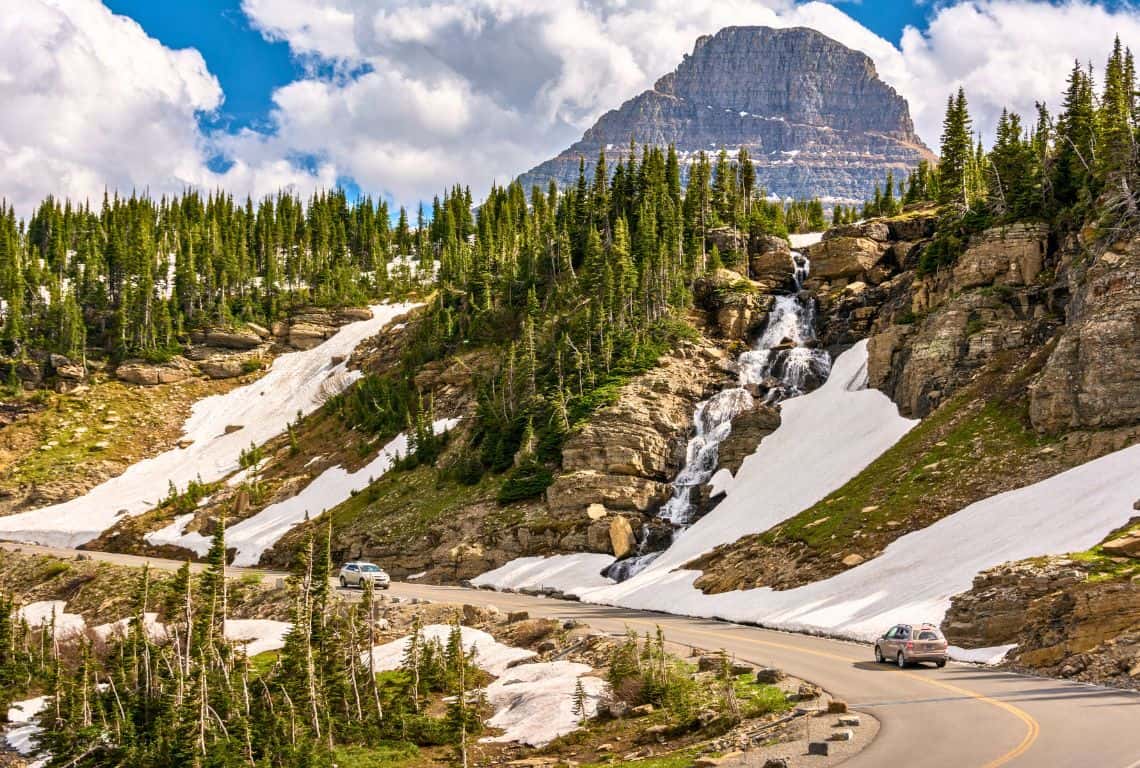
When’s the Best Time to Drive Going-to-the-Sun Road? / Snow in Late June still Lingering on Going-to-the-Sun Road
The peak tourist season in Glacier National Park, including Going-to-the-Sun Road, is generally from late June to early September. During this time, the road is fully accessible, and all facilities and services along the route are open. The weather is generally pleasant, and the park is in full bloom, with wildflowers dotting the alpine meadows.
INTREPID’S PRO TIP: I prefer fewer crowds and more tranquility, that is why I always visit during the shoulder seasons of late May to early June or September to early October. During these times, the park is still accessible, however, there may be some restrictions or reduced services. But, you can enjoy the stunning fall foliage in September and the emergence of spring blooms in May.
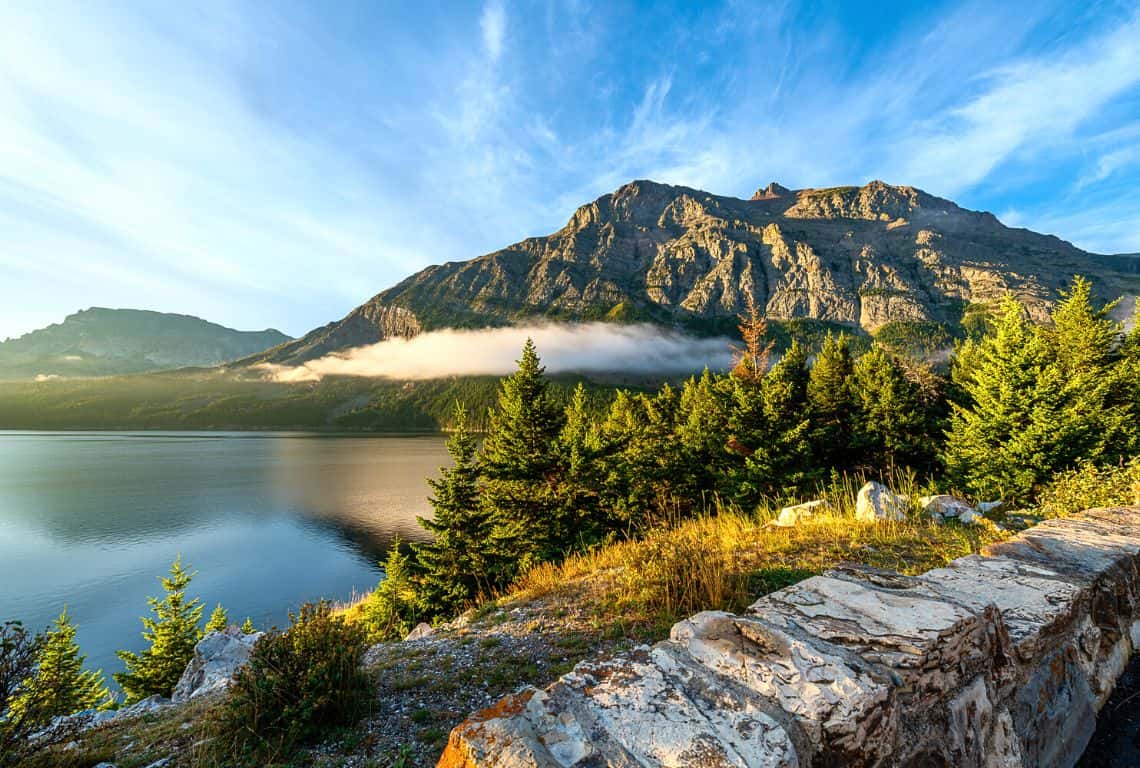
Stunning Views Along Going-to-the-Sun Road in Glacier National Park
Should You Use the Shuttle, Tour Company, or Drive Your Vehicle?
- Drive Your Vehicle
Driving your car or renting a car is the best option to get around Glacier National Park and, for that matter, traveling on Going-to-the-Sun Road. This option is the most convenient and gives you the most flexibility.
- Use Going-to-the-Sun Shuttle Service
Glacier National Park offers West and East Shuttle Service that operates on the Going-to-the-Sun Road. There are some pros and cons to using the shuttle. Here is what you need to know:
1. West and East Shuttle Services are free (cost is included in your entrance pass). You can hop on/hop off at any of the shuttle stops. The shuttle operates on a first-come, first-serve basis. Shuttles are wheelchair accessible and some have bike racks.
2. Going-to-the-Sun Shuttle Service usually operates from July 1st through Labor Day (weather permitting).
3. West Shuttle runs from Apgar Visitor Center to Logan Pass and has 5 stops along the way. It operates 7 days a week from 7 am till 7 pm.
4. East Shuttle runs from St. Mary Visitor Center to Logan Pass and makes 8 stops along the way. It operates 7 days a week from 8 am till 7 pm.
5. To traverse the entire Going-to-the-Sun Road using the shuttle system, you will need to make several transfers along the way at Avalanche Creek, Logan Pass, and Sun Point.
6. Shuttles that run from Apgar Visitor Center, Avalanche Creek, Sun Point, and St. Mary Visitor Center have a 28-passenger capacity and run approximately every 30-40 minutes.
7. Shuttles operating between Avalanche Creek and Logan Pass and, then from Logan Pass and Sun Point are small and can only take 12-15 passengers. They run approximately every 15-20 minutes.
INTREPID’S PRO TIP: From my personal experience, the shuttle system is not the best option. If you decide to use it, then be prepared to wait in line for some time until there is an open seat.
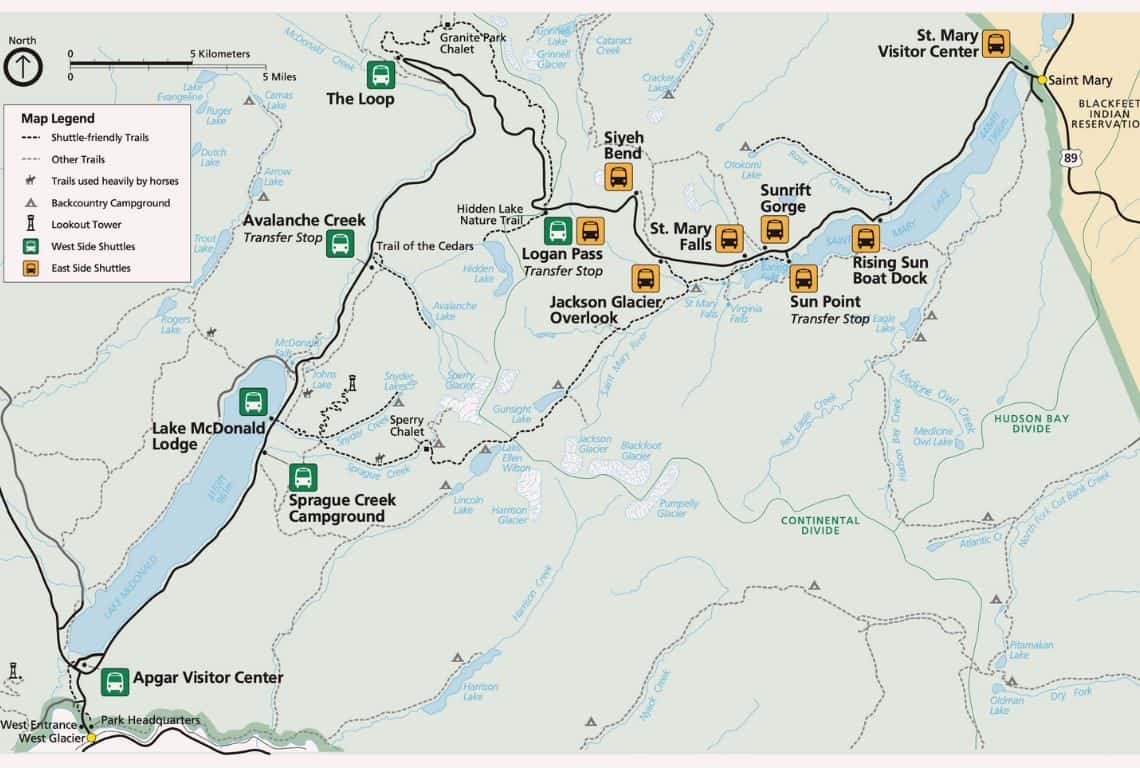
Glacier National Park Shuttle Service Map / Image Credit: NPS / Best Stops on Going-to-the-Sun Road
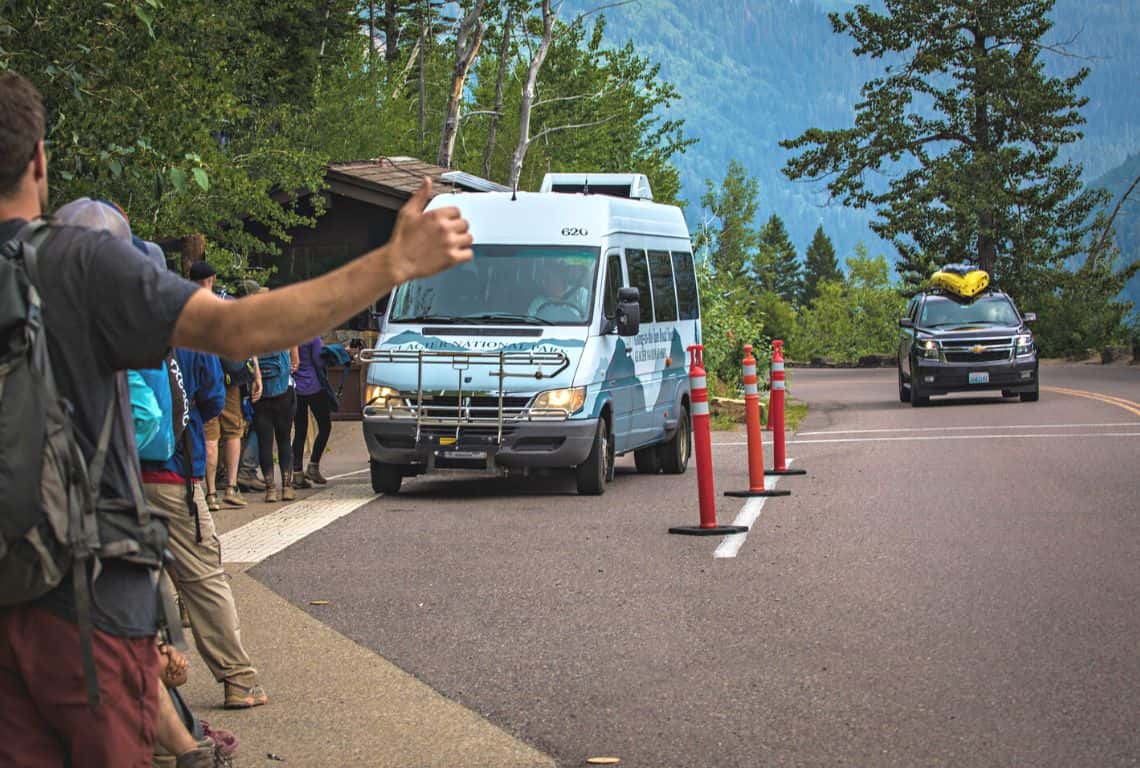
Going-to-the-Sun Road Shuttle Service / Best Stops on Going-to-the-Sun Road
- Go with a Tour Company
Sun Tours offers interpretive tours, on air-conditioned 25-passenger window coaches, highlighting Blackfeet culture. Daily service from West Glacier, East Glacier, St. Mary, and Browning during the peak season.
Xanterra Parks & Resorts offers tours in their signature Red Jammers – classic open-air shuttles.
INTREPID’S PRO TIP: There are some pluses and minuses to going on a tour. Personally, it is not my favorite way of exploring any place. However, going on a tour is convenient, since you do not have to drive yourself and you can just sit and relax and enjoy the scenery.
Tips for Navigating Going-to-the-Sun Road
Driving Going-to-the-Sun Road in Glacier National Park can be a thrilling and awe-inspiring experience, but it’s important to be aware of the challenges that come with it.
The road is known for its steep grades, hairpin turns, and narrow sections, which require caution and focus behind the wheel.
The elevation changes throughout the route, reaching over 6,600 feet at Logan Pass, can also affect driving conditions.
Additionally, the road can be subject to adverse weather conditions, including sudden rain showers and the potential for snow at higher elevations, even during the summer months.
Here are a few tips for driving the Going-to-the-Sun Road:
- Take breaks at designated turnouts to enjoy the breathtaking views.
- Allow faster traffic to pass to enhance both your safety and enjoyment.
- Stay alert and cautious while driving. Especially, pay attention around blind curves, as animals and pedestrians often cross the road unexpectedly.
- Adhere to the posted speed limit which is 40 miles per hour in lower elevations and 25 miles per hour in higher elevations.
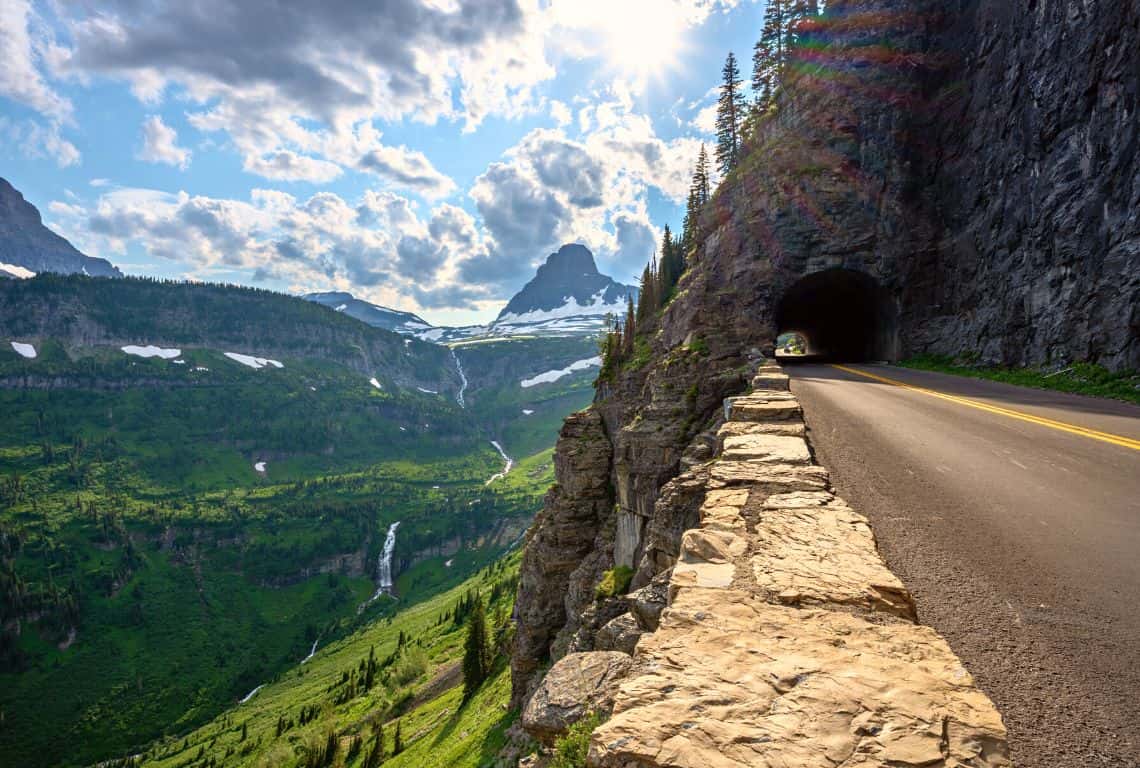
Going-to-the-Sun Road in Glacier National Park / Best Stops on Going-to-the-Sun Road
Vehicle Size Restrictions
When planning to drive on Going-to-the-Sun Road in Glacier National Park, it is important to be aware of the vehicle size restrictions in place. The road features narrow sections, tight curves, and low overhanging rocks, which can pose challenges for larger vehicles.
Currently, the maximum vehicle dimensions allowed on the road are 21 feet in length, 10 feet in height, and 8 feet in width. It’s crucial to measure your vehicle and compare it against these limits before embarking on your journey.
If your vehicle exceeds these dimensions, alternative transportation options such as the park shuttle service may be a better choice for exploring Going-to-the-Sun Road.
GOOD TO KNOW: Between Lake McDonald and Avalanche Lake, any size or height vehicles can drive on the Going-to-the-Sun Road. Vehicles and vehicle combinations longer than 21 feet (including bumpers) or wider than 8 feet (including mirrors) are prohibited between Avalanche Creek and Rising Sun. Vehicles over 10 feet in height may have difficulty driving west from Logan Pass to the Loop, due to rock overhangs.

Vehicle Size Limits on Going-to-the-Sun Road / Image Credit: NPS / Best Stops on Going-to-the-Sun Road
Availability of Bathroom Facilities
As you embark on your journey along Going-to-the-Sun Road in Glacier National Park, it’s natural to wonder about the availability of bathroom facilities along the route.
Rest assured, the park has made provisions to ensure visitor comfort and convenience. At various locations along the road, you’ll find restroom facilities strategically placed to cater to the needs of travelers.
INTREPID’S PRO TIP: From my personal experience, the availability of bathrooms sometimes changes, however, you can count on having bathrooms at the three visitor centers along the way at Apgar, Logan Pass, and St. Mary. In addition, you will find drinking water stations, trip planning information, bookstores, and exhibits.
Get a Reservation Ticket to Drive on Going-to-the-Sun Road
- In 2024, between May 24th and September 8th, from hours 6 am to 3 pm MDT, you are required to have a reservation ticket to access the Going-to-the-Sun Road.
- You can drive on the Going-to-the-Sun Road before 6 am and after 3 pm without a reservation ticket. If you are not able to get a reservation ticket, then make the drive after 3 pm. You will still be able to enjoy the views, do a couple of short hikes, and catch a breathtaking sunset.
GOOD TO KNOW: You can reserve the pass to drive the Going-to-the-Sun Road at Recreation.gov. The pass is valid for 1 day and costs $2.00. The reservation pass and the park pass are required to enter the Going-to-the-Sun Road. Reservations become available 120 days before the day you want to get a reservation and the day before at 8 am MDT.
Visitors with service reservations along the Going-to-the-Sun Road corridor do not need a vehicle reservation. If you have camping or lodging reservations, commercial tours, and horseback riding reservations along the Going-to-the-Sun Road, you do need a reservation pass to drive the road.
What to Bring on Going-to-the-Sun Road?
When embarking on a scenic adventure along Going-to-the-Sun Road in Glacier National Park, it’s important to come prepared with some essential items. Here is a list of what to bring on your journey through Going-to-the-Sun Road:
- Clothing Layers: Glacier National Park’s weather can be unpredictable, even during the summer months. Pack clothing layers that can be easily added or removed to accommodate temperature changes throughout the day. Include a waterproof and windproof jacket for protection against sudden rain showers or chilly mountain breezes.
- Snacks and Water: Bring ample snacks and water to stay hydrated and energized during your journey. Opt for portable and non-perishable snacks like trail mix, energy bars, and fruits to keep you fueled throughout the day.
- Sun Protection: Glacier National Park’s high elevation and open landscapes make sun protection essential. Pack sunscreen, a hat, sunglasses, and lip balm with SPF to shield yourself from the sun’s rays, especially during midday hours.
- Binoculars and Camera: Enhance your wildlife spotting and capture stunning photographs by bringing binoculars and a camera with extra batteries and memory cards. Glacier National Park is home to a diverse array of wildlife, and you wouldn’t want to miss any memorable sightings.
- First Aid Kit: A basic first aid kit is always a good addition to your packing list. Include essentials such as adhesive bandages, pain relievers, antiseptic wipes, and any necessary personal medications.
- Outdoor Essentials: Depending on whether you will do some short hikes along the way, consider bringing hiking gear such as sturdy footwear, backpacks, trekking poles, and insect repellent.
Glacier National Park Going-to-the-Sun Road Map
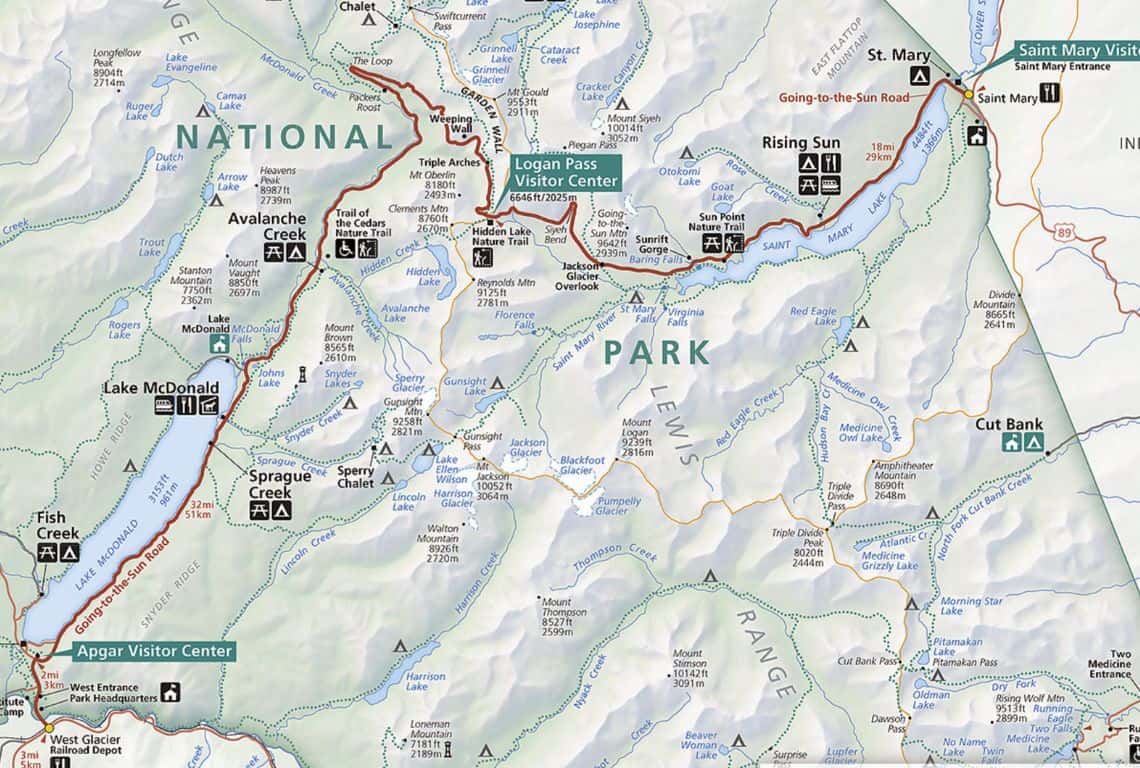
Glacier National Park Going-to-the-Sun Road Map / Image Credit: NPS / Best Stops on Going-to-the-Sun Road
18 Best Stops on Going-to-the-Sun Road
In this blog post, we will traverse Going-to-the-Sun Road from west to east and we will start at Apgar Visitor Center which is located approximately 2 miles from the West Entrance.
INTREPID’S PRO TIP: First of all, when you get to the West Entrance, make sure to refuel your vehicle since there are no gas stations inside the park! Next, visit Apgar Visitor Center and talk to the rangers to get updates regarding weather conditions, road or trail closures, as well as any recent wildlife sightseeing. Check out the bookstore and some exhibits as well. Finally, stock up on any snacks and water, and use the restroom.
And now, with no further delay, let’s explore the best stops on Going-to-the-Sun Road!
Lake McDonald - Mile Marker 2
Lake McDonald is the largest lake in Glacier National Park. It is a classic glacial fjord-like lake filling the basin carved out by erosion and Ice Age Glaciers. It is 10 miles long, over a mile wide, and 472 feet deep.
The views of the turquoise waters surrounded by towering mountains in the distance are picture-perfect!
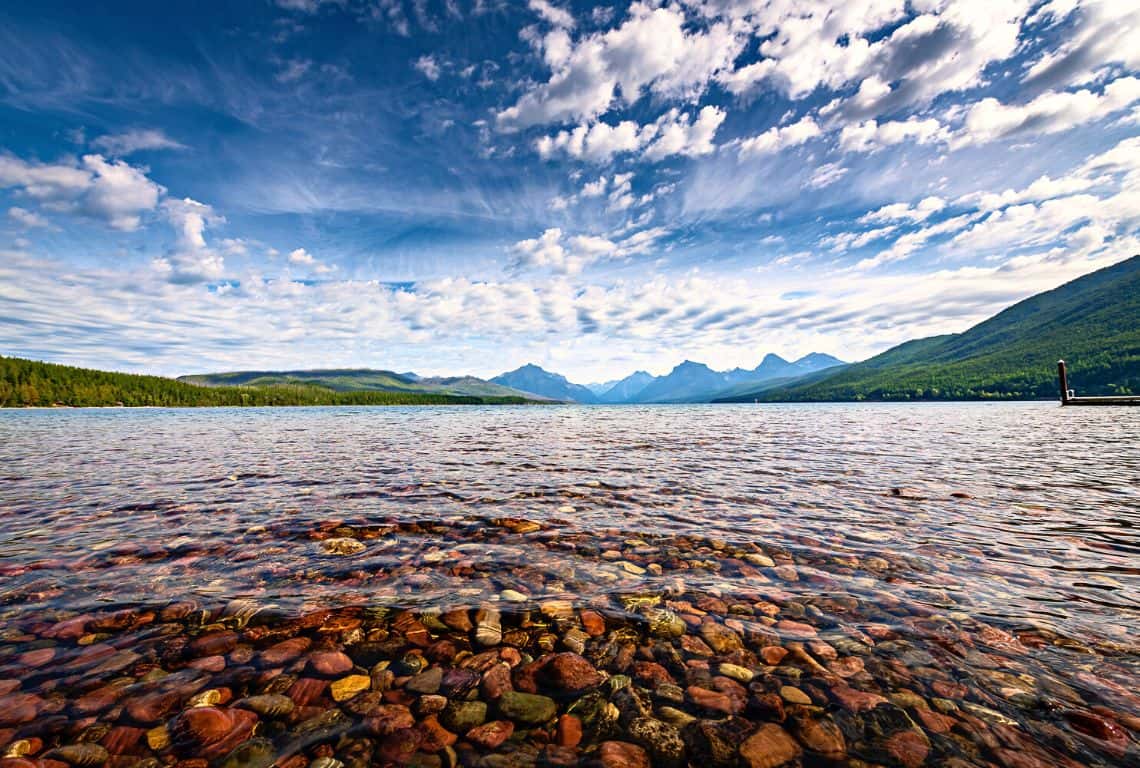
Lake McDonald in Glacier National Park / Best Stops on Going-to-the-Sun Road
However, one of the striking features that I am sure you will notice right away is a variety of beautifully colored rocks, stones, and pebbles just below the surface of the crystal-clear water and on the shores of the lake. The colors are amazing and range from yellowish and red to dark red, and from green to blue.
The color of the rocks is determined by the presence or absence of iron. The bright red rocks found along the Grinnell Glacier trail were deposited in a shallow ocean environment where the iron was oxidized by tidal exposure to the air. Rocks with this coloration often have old ripple marks or ancient mud crack lines.
The rich green-colored rocks were formed in deeper water than the red rocks. Although these rocks contain the same quantities of iron-bearing minerals, they did not have the same exposure to oxygen and the amount of oxidization was limited.
Source: Glacier-Waterton International Peace Park Vicky Spring and Tom Kirkendall
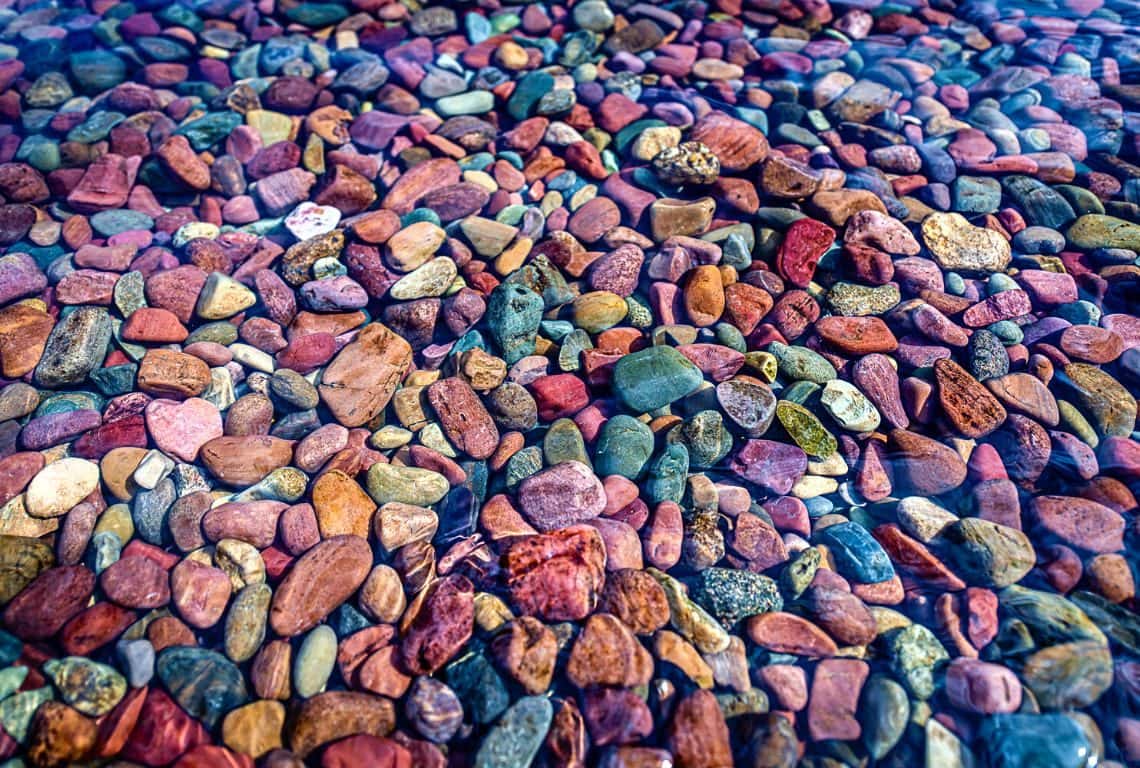
Lake McDonald in Glacier National Park / Best Stops on Going-to-the-Sun Road
There are many access points to the lake on the Going-to-the-Sun Road. And, besides enjoying the views, you can swim in the lake, kayak, or paddleboard.
GOOD TO KNOW: Glacier Outfitters is a place to get all your rentals. They have single, tandem, child, fishing kayaks, and paddle boards. Also, they rent bikes!
If you like fishing, then Lake McDonald is a good spot. My daughter, who is an avid fisherwoman, likes to fish here. You will find numerous native trout species at Lake McDonald: westslope cutthroat trout, rainbow trout, and bull trout.
While driving along Lake McDonald, you will pass by Sprague Creek Campsite and historic Lake McDonald Lodge.
Lake McDonald Lodge is a 3-story Swiss chalet-style lodge built in 1913 and it is worth a quick stop. It has 82 guest rooms, a rustic dining room, a reading area, and a lounge. It was based on a design by famed architect Kirtland Cutter, whose other works include the Davenport Hotel in Spokane and the Conrad Mansion in Kalispell.
Lake McDonald Falls and Johns Lake Loop Trail - Mile Marker 12
Once you reach the end of Lake McDonald, you will get to McDonald Falls.
You can view the falls from the road, however, my recommendation is to take a short and easy loop trail called Johns Lake Loop (the trail is 1.9 miles round trip with an elevation change of about 183 feet) that will not only get you closer to McDonald Falls for better views, but you will also get to visit the Johns Lake and see the beautiful Sacred Dancing Cascade.
INTREPID’S PRO TIP: The parking area is very small at this stopping point. It can fit no more than 7-8 cars. So, if all the spots are full, then proceed to the next stop, which is Sacred Dancing Cascade Viewpoint. You will be able to see Sacred Dancing Cascade as well as hike Johns Lake Loop Trail from this next location as well.
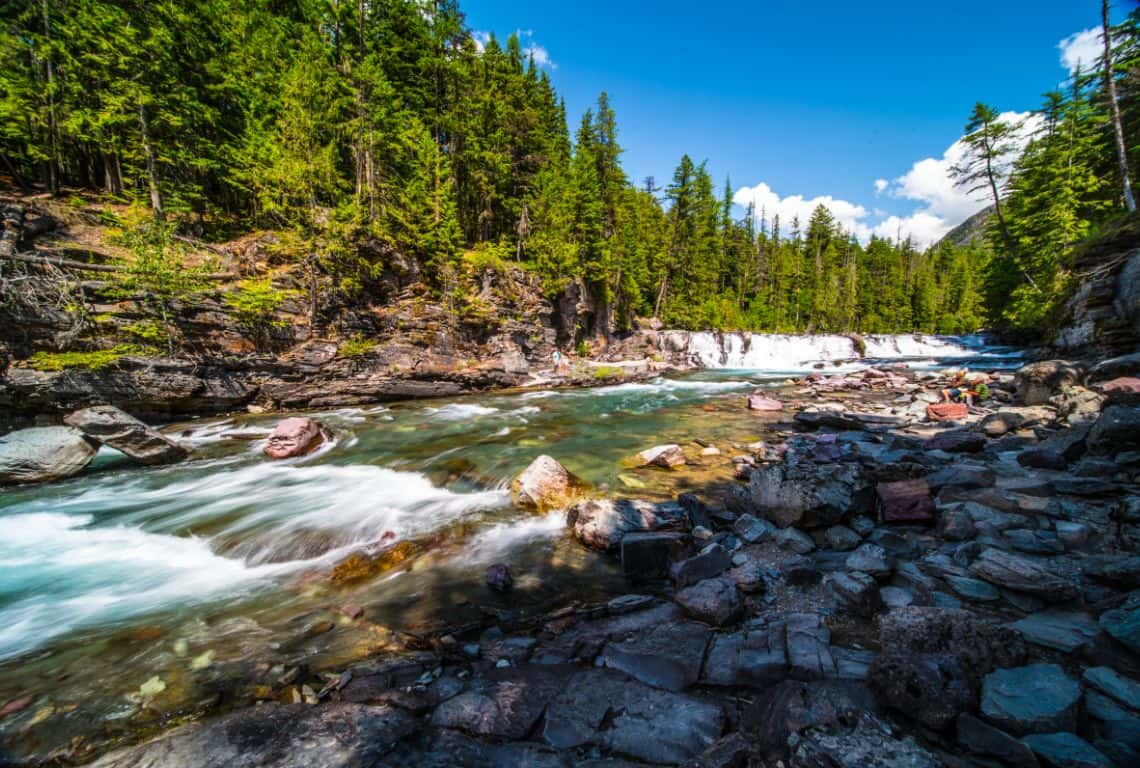
Johns Lake Loop Trail / Best Stops on Going-to-the-Sun Road
Sacred Dancing Cascade Viewpoint - Mile Marker 13.5
A short path, right off the Going-to-the-Sun Road, will take you directly to the footbridge where you will be able to catch a pretty good view of the Sacred Dancing Cascade.
The cascade gets its name from the Kootenai phrase which means “a good place to dance” or “where people dance”.
INTREPID’S PRO TIP: If you were not able to find parking at the last stop and as a result not able to hike Johns Lake Loop, then this is a perfect starting point as well. You can do the loop in either direction. This short and easy trail will take you to Lake McDonalds Falls and Johns Lake.
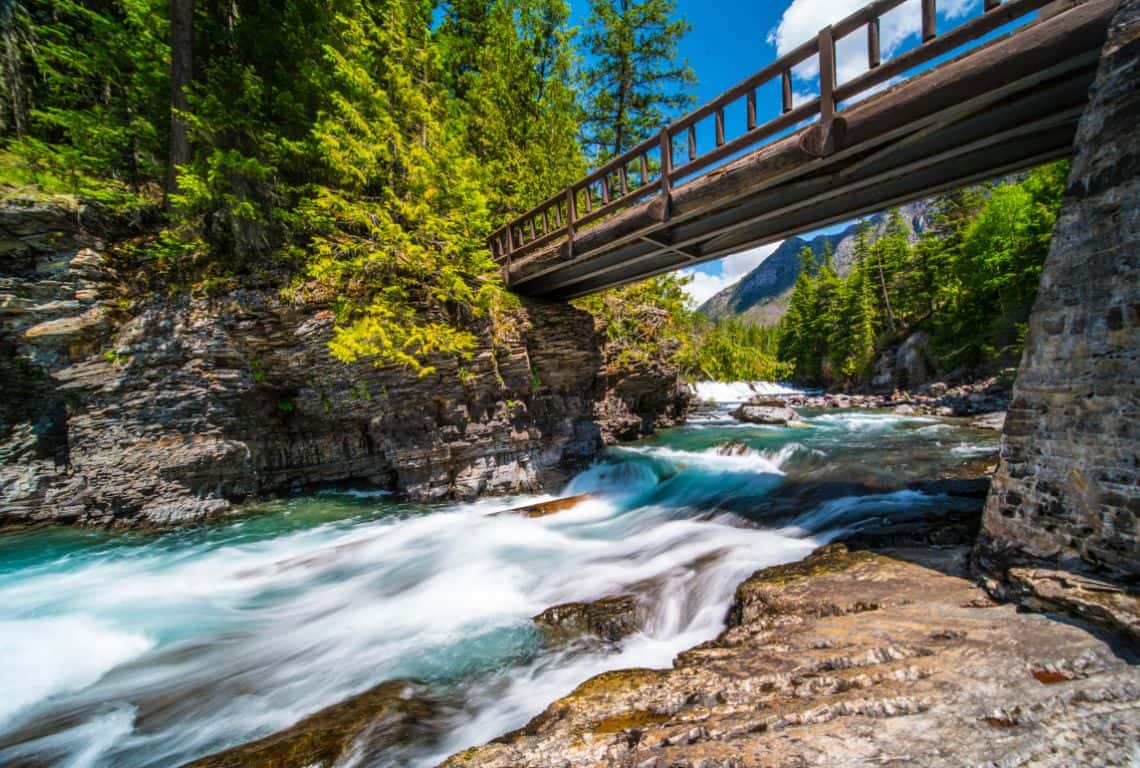
Johns Lake Loop Trail / Best Stops on Going-to-the-Sun Road
Avalanche Creek and Trail of the Cedars - Mile Marker 16
Avalanche Creek is one of the most popular stopping points on the Going-to-the-Sun Road. There is a campground here, lots of picnic areas, and a trailhead to the Trail of the Cedars and Avalanche Lake.
The Trail of the Cedars is a short and easy hike, on top of that, it is wheelchair accessible. The trail is a loop and you can do it either way. Most people start on the east side and continue along a raised boardwalk. The trail will take you through a forest of ancient western cedars.
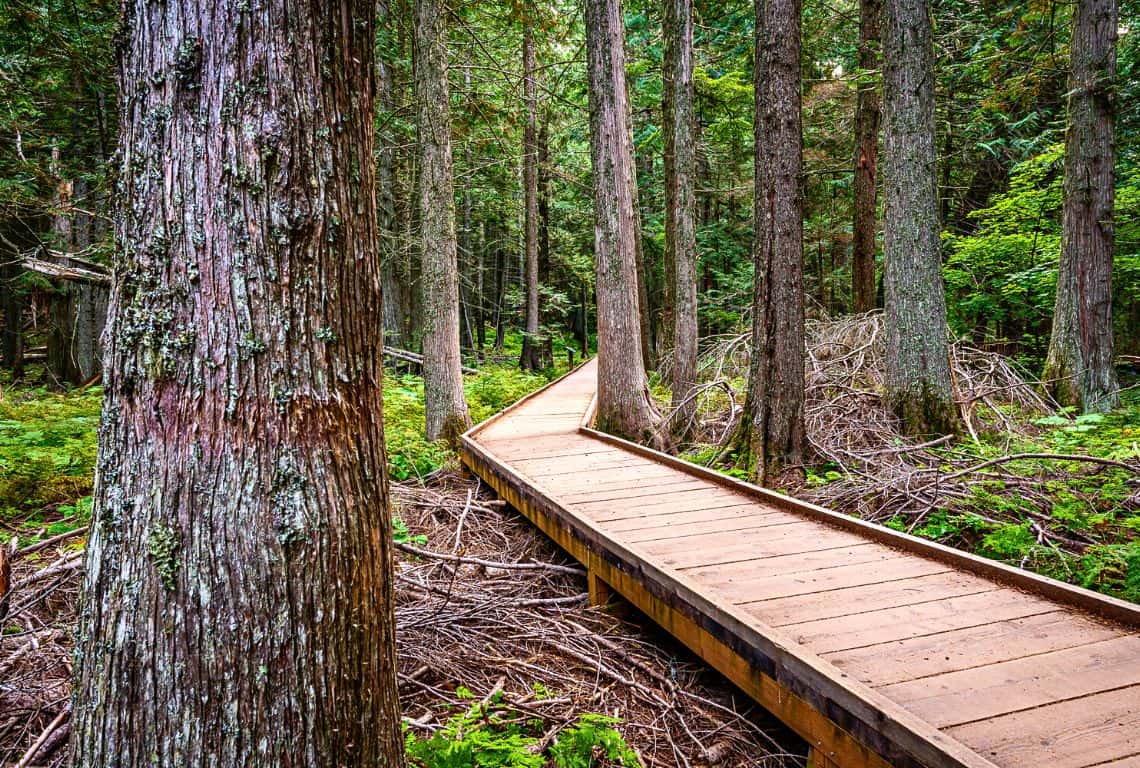
The Trail of the Cedars / Best Stops on Going-to-the-Sun Road
At about halfway point, you will reach a footbridge over Avalanche Creek and get to enjoy awesome views of the lower Avalanche Gorge.
Just past this section is a junction to the Avalanche Lake Trail. If you are up to it, then hike for no more than 600 feet and you will reach a narrow gorge with cascading water. It is a strenuous section, entirely up the hill at a steep incline. However, it is so worth the effort!
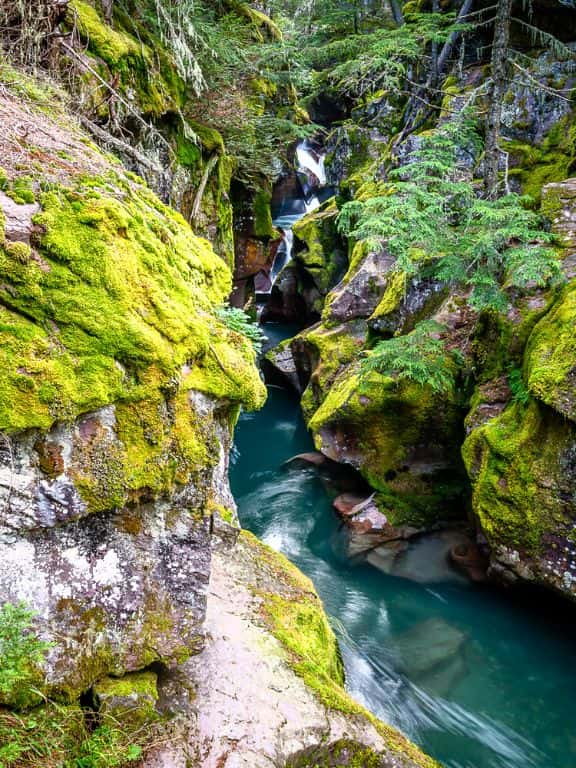
The Trail of the Cedars / Best Stops on Going-to-the-Sun Road
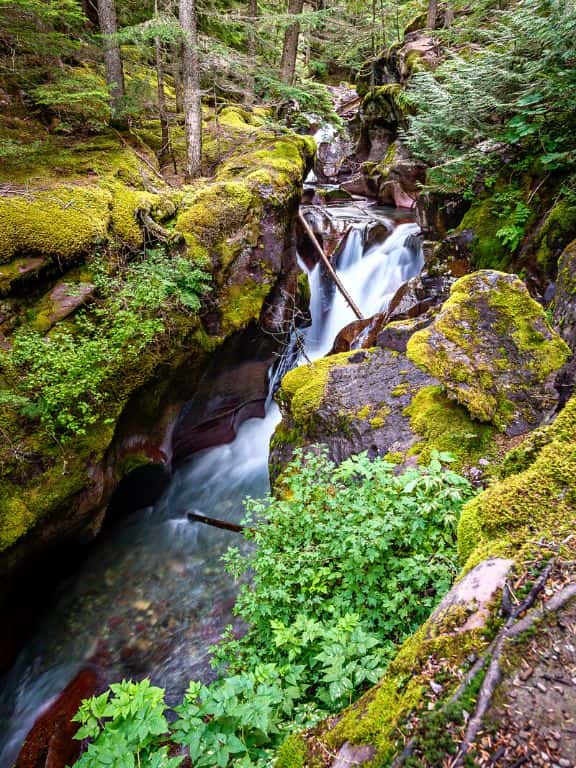
The Trail of the Cedars / Best Stops on Going-to-the-Sun Road
The trail continues to Avalanche Lake. If you are up to it, then I want to encourage you to hike to Avalanche Lake. It will be 2.3 miles from the trailhead before you reach the lake and ahead of you will be a moderate climb to reach the lake.
However, you will not be disappointed, because the views of this gorgeous lake are simply off the charts. It sits in a bowl-shaped canyon surrounded by Bearhat Mountain, Little Matterhorn, and Mount Brown with numerous waterfalls cascading down into the lake.
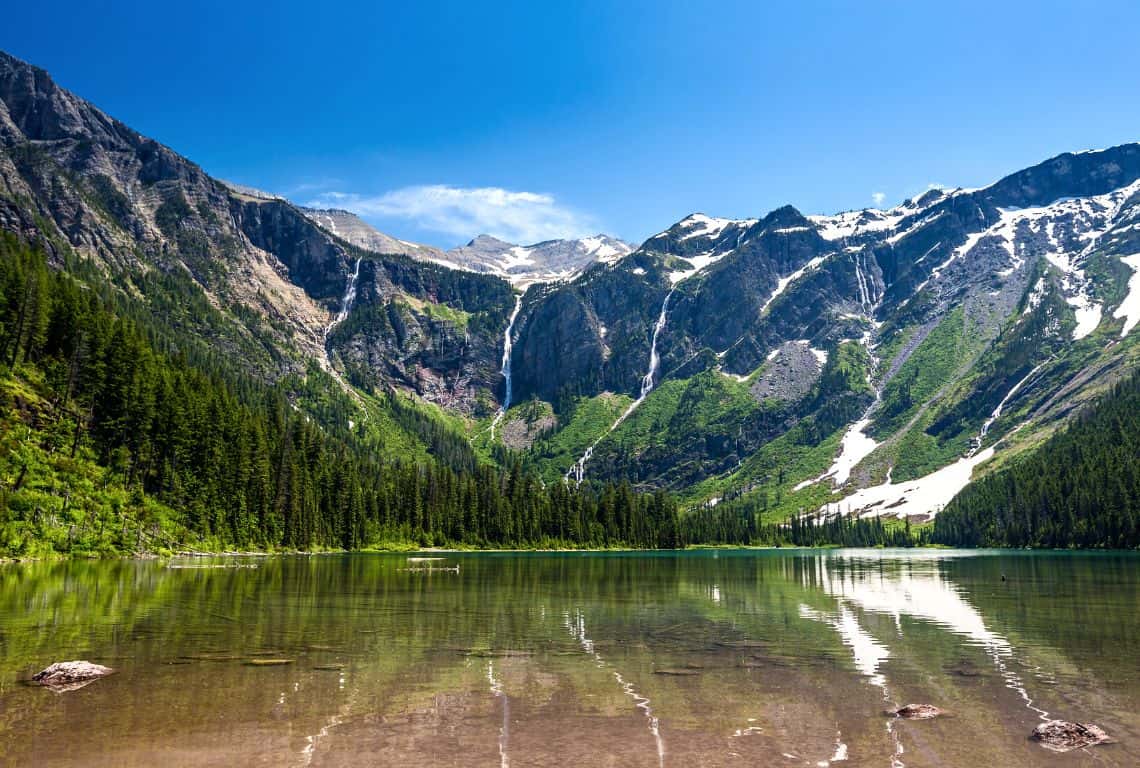
Avalanche Lake Trail / Best Stops on Going-to-the-Sun Road
West Side Tunnel - Mile Marker 23
Next, the Going-to-the-Sun Road passes through the West Tunnel. It is the first of the two tunnels that you will be going through.
The tunnel was constructed between 1926-1927. This iconic spot features window ports that overlook Heavens Peak and the Upper McDonald Creek Valley.
Immediately past the tunnel, there is a small pullout. It is a perfect spot to take a short break and appreciate the views. Or, you can walk back through the tunnel to peer out of the window ports.
West Tunnel on Going-to-the-Sun Road / Best Stops On-Going-to-the-Sun Road
The Loop - Mile Marker 24
The Loop is a giant switchback on the Going-to-the-Sun Road.
The view of Heavens Peak standing 8,991 feet high is outstanding from this stopping point.
You will see a lot of hikers at this place. Some are going to and some coming back from the Granite Park Trail and Highline Trail, which are, hands down, one of the most popular trails in Glacier National Park. By the way, these trails need to be on your Glacier National Park bucket list.
INTREPID’S PRO TIP: If you can hike just one trail in Glacier National Park, then make sure it is the Highline Trail. The Loop is a good spot to end this trail, and then catch a shuttle back to Logan Pass. Logan Pass is definitely where you want to start hiking this trail.
We will cover the Highline Trail in more detail, once we get to Logan Pass.
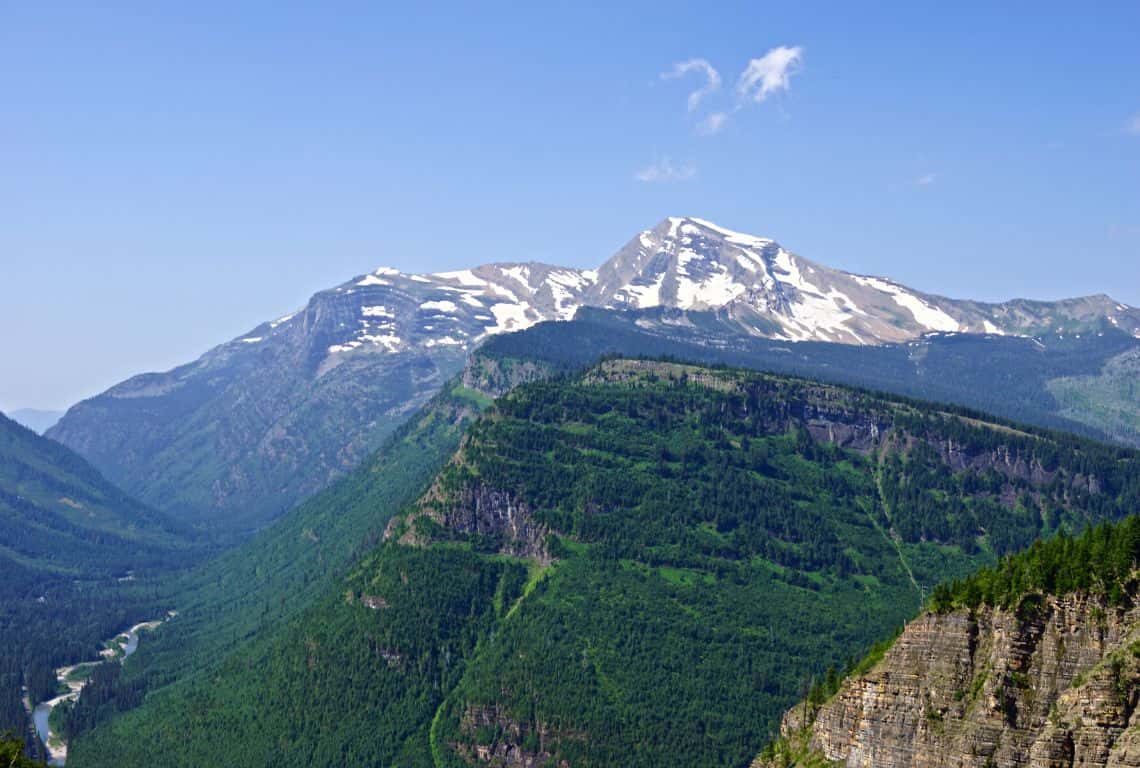
Heavens Peak on Going-to-the-Sun Road / Best Stops on Going-to-the-Sun Road
Bird Woman Falls and Haystack Creek Falls - Mile 27 and 28
Bird Woman Falls and Haystack Creek Falls are two of the tallest waterfalls in Glacier National Park.
You will be able to see majestic Bird Woman Falls from different angles as you are driving on the Going-to-the-Sun as they drop 560 feet from the north face of Clements Mountain.
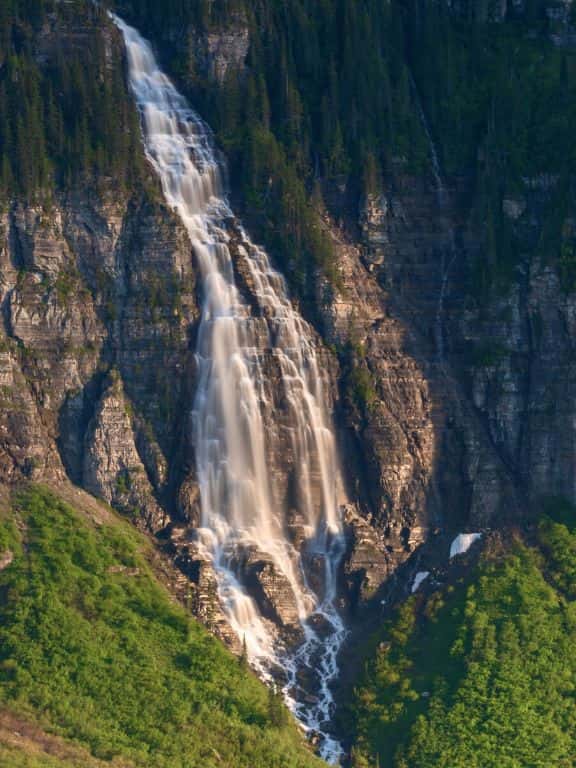
Bird Woman Falls and Haystack Falls on Going-to-the-Sun Road / Best Stops on Going-to-the-Sun Road
Once you reach Haystack Creek Falls, you will be able to drive under them as there is an arch built over the road to allow the water to continue cascading down the mountain.
INTREPID’S PRO TIP: If you need to take more pictures, there is a small pullout right after you pass the falls.
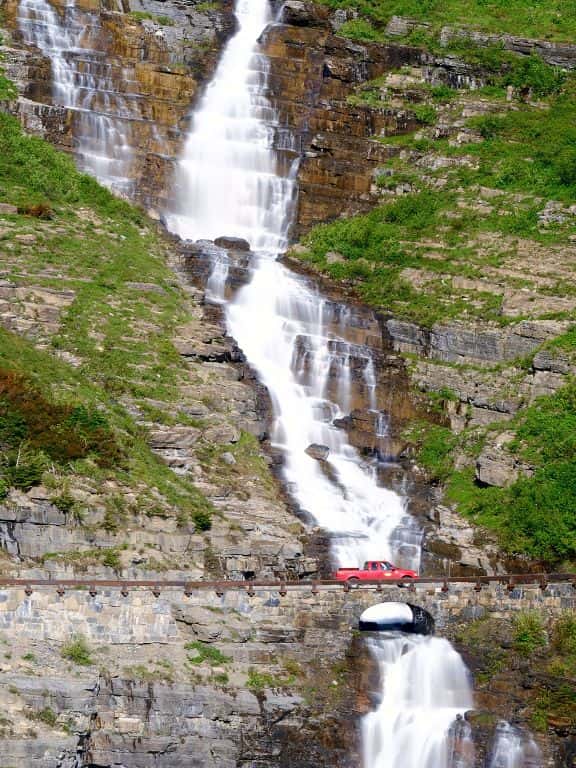
Bird Woman Falls and Haystack Falls on Going-to-the-Sun Road / Best Stops on Going-to-the-Sun Road
The Weeping Wall - Mile Marker 29
The Weeping Rock is not a stop, but it is worth mentioning since you will be passing by it.
The Weeping Wall is a huge rock adjacent to the Going-to-the-Sun Road that is covered with water that makes it look like it’s weeping.
Depending on when you are visiting Glacier National Park, you might not only see the water soaking the rock but also pretty substantial waterfalls cascading down the wall and flooding the road.
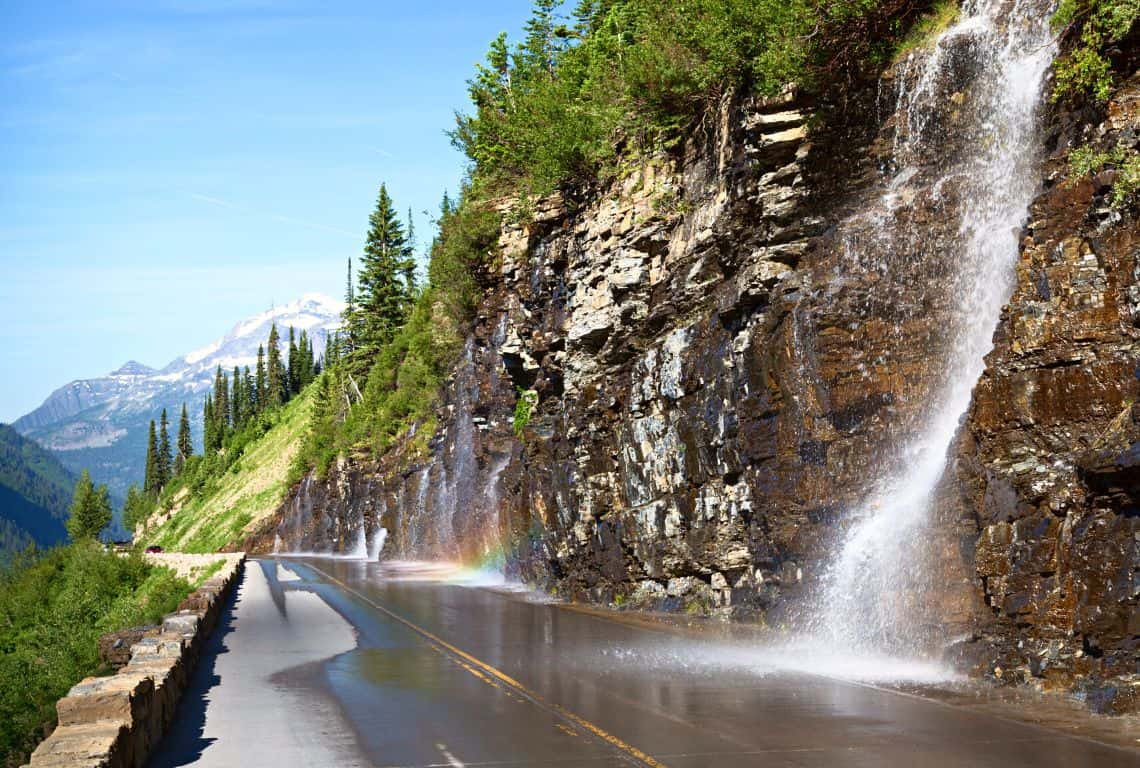
The Weeping Wall on Going-to-the-Sun Road / Best Stops on Going-to-the-Sun Road
The Big Bend And the View of the Triple Arches - Mile Marker 30
You will reach the Big Bend right after you pass the Weeping Wall. It is a huge U-shaped turn on the Going-to-the-Sun Road. There is plenty of parking at this place, so you should not have any issues finding a spot.
This is the perfect spot to soak in the views of the mountains surrounding the valley below. You can see Cannon Mountain, Mount Oberlin, Heavens Peak, and Clements Mountain in the distance.
Also, the views of the Going-to-the-Sun Raod as it winds up and down the mountainsides are very good at this spot and you can appreciate this engineering marvel.
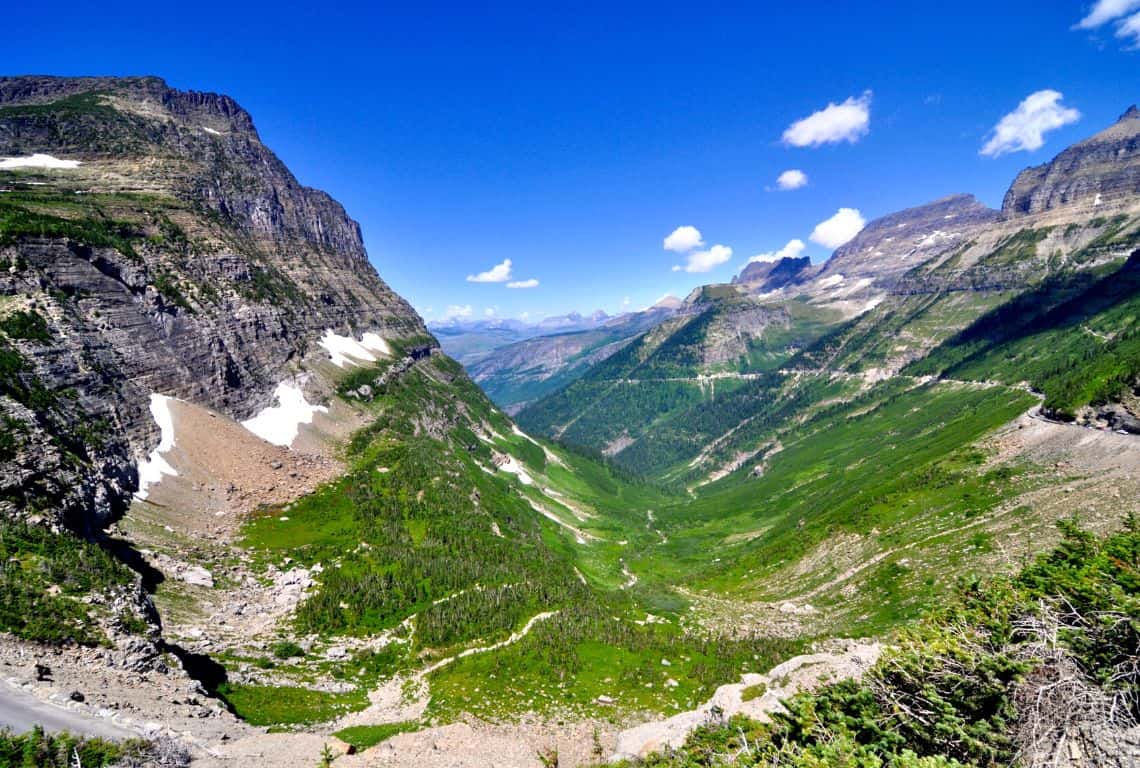
Big Bend on Going-to-the-Sun Road / Best Stops on Going-to-the-Sun Road
Finally, you will get a good view of the famous Triple Arches up ahead, a 60-foot section of road featuring impressive stone masonry supporting the Going-to-the-Sun Road.
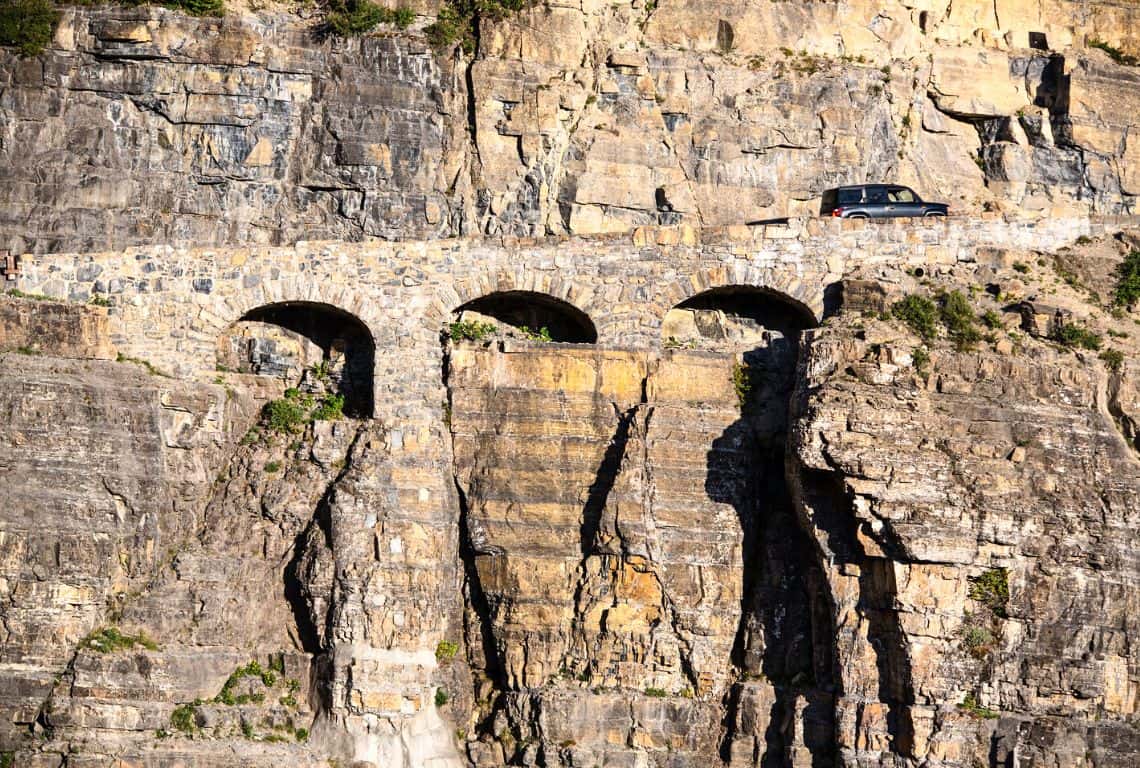
Triple Arches on Going-to-the-Sun Road / Best Stops on Going-to-the-Sun Road
The Oberlin Bend Overlook - Mile Marker 31
Just before you reach Logan Pass, there is a small pullout for the Oberlin Bend Overlook.
A short boardwalk will take you to the viewpoint. The views of the valley and a dominating Mount Oberlin in the distance are awesome.
Be on the lookout for mountain goats and marmots!
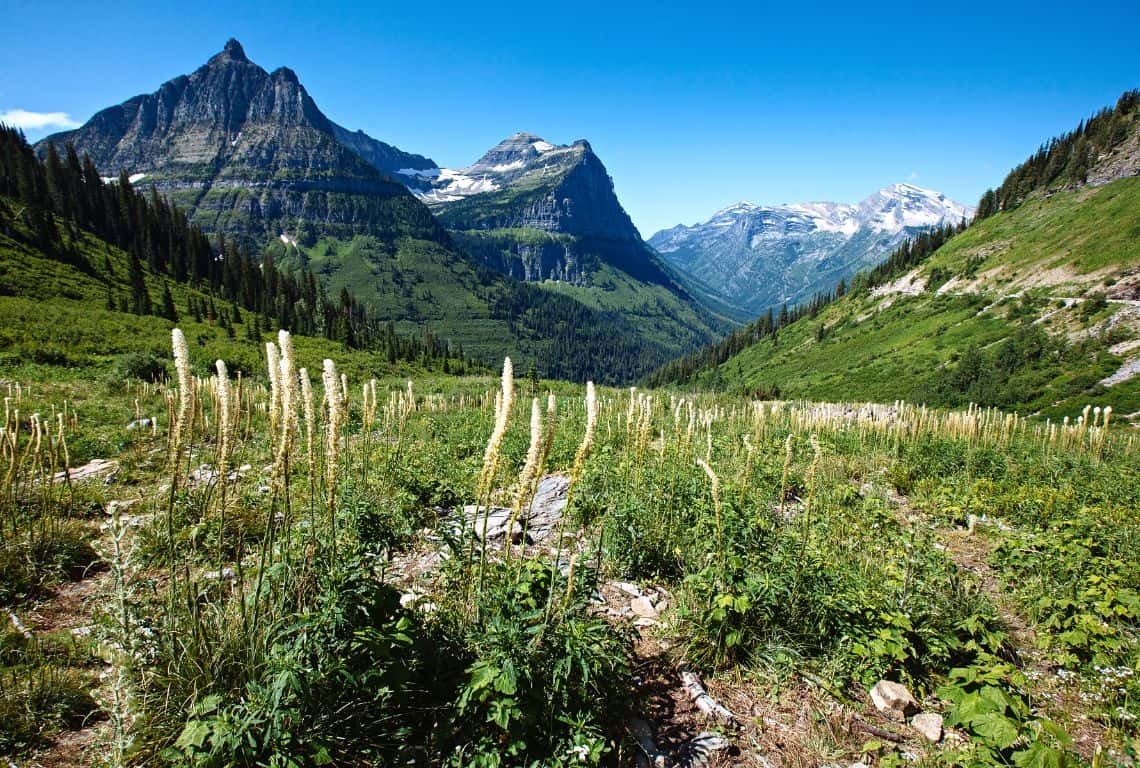
Mt. Oberlin on Going-to-the-Sun Road / Best Stops on Going-to-the-Sun Road
Logan Pass - Mile Marker 32
Logan Pass is the highest point reachable by a vehicle on the Going-to-the-Sun Road. It sits at an elevation of 6,646 feet.
Just a heads up, this is one of the busiest spots on the Going-to-the-Sun Road and it gets very crowded, and you might have to wait for a parking spot.
All in all, the views are awesome here. So, take a few minutes and enjoy the picturesque views of Reynolds Mountain and Clements Mountain in the distance, along with meadows of wildflowers. Also, the views of the Bearhat Mountian right behind the Logan Pass Visitor Center are stunning!
INTREPID’S PRO TIP: Before jumping back into your vehicle and continuing on the Going-to-the-Sun Road, make sure to take a peek into the Logan Pass Visitor Center, use the restroom, and refill your water bottles.
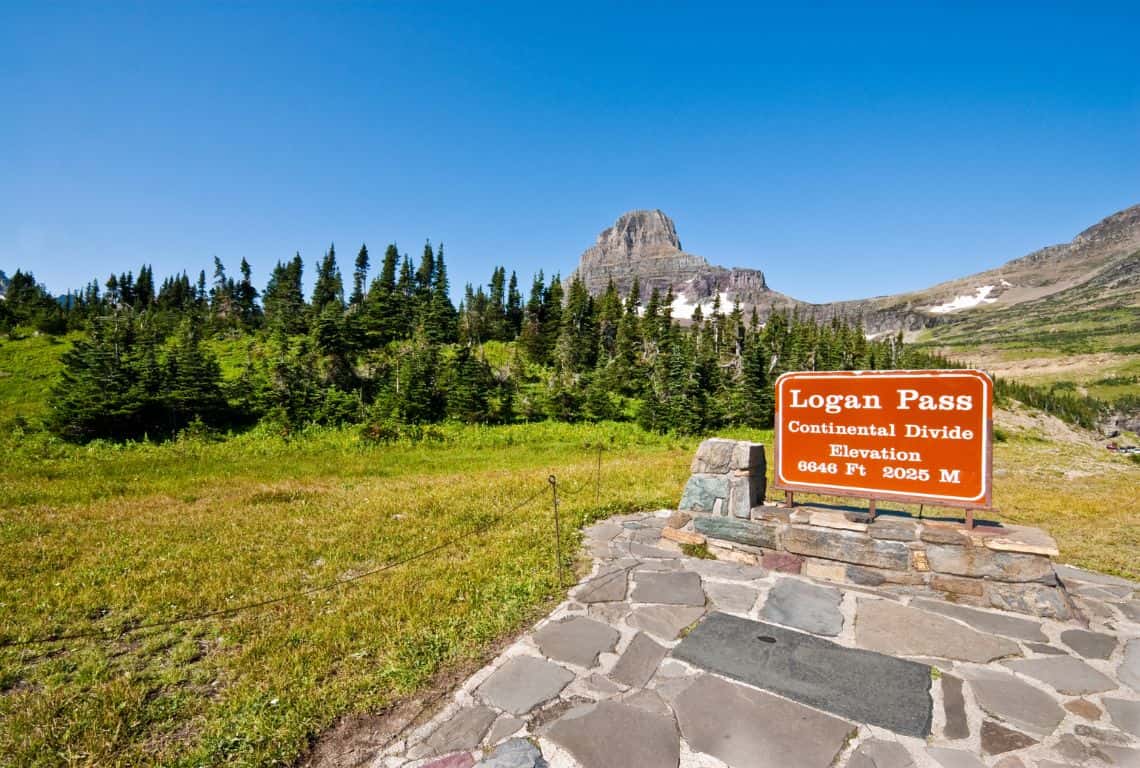
Logan Pass / Best Stops on Going-to-the-Sun Road
GOOD TO KNOW: I need to mention that two of the most popular hikes originate from Logan Pass: Hidden Lake Overlook Trail and Highline Trail. Both are challenging trails, however, the views along the way are stunning and both of these trails should be on your bucket list of things to do in Glacier National Park.
Lunch Creek - Mile Marker 33
Lunch Creek is a delightful place to stop and take a short break or have a picnic lunch here.
Also, this is a perfect spot to see Big Horn Sheep. They like to cross the creek back and forth especially early in the morning and the evening.
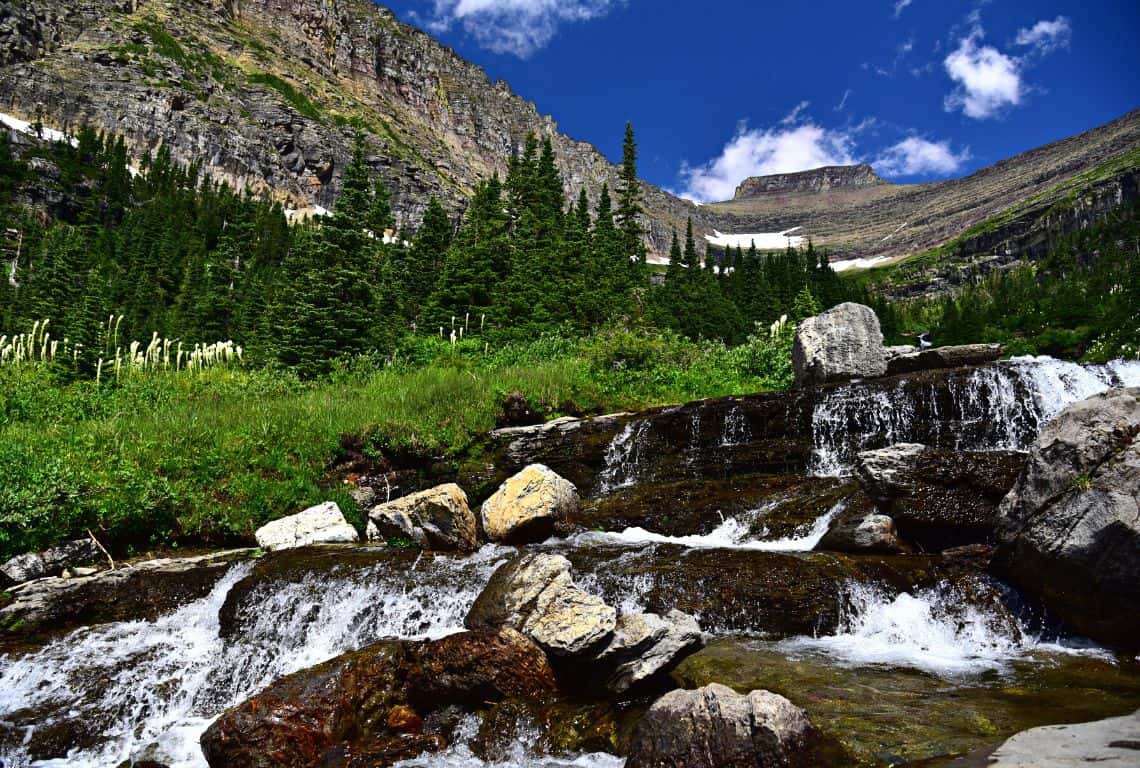
Lunch Creek / Best Stops on Going-to-the-Sun Road
East Tunnel - Mile Marker 34
East Tunnel on the Going-to-the-Sun Road is the second tunnel that you will be going through.
It is 408 feet long and it is said that it was one of the more difficult features to accomplish while the Going-to-the-Sun was being constructed in 1932. This structure was entirely built by hand labor instead of powered equipment.
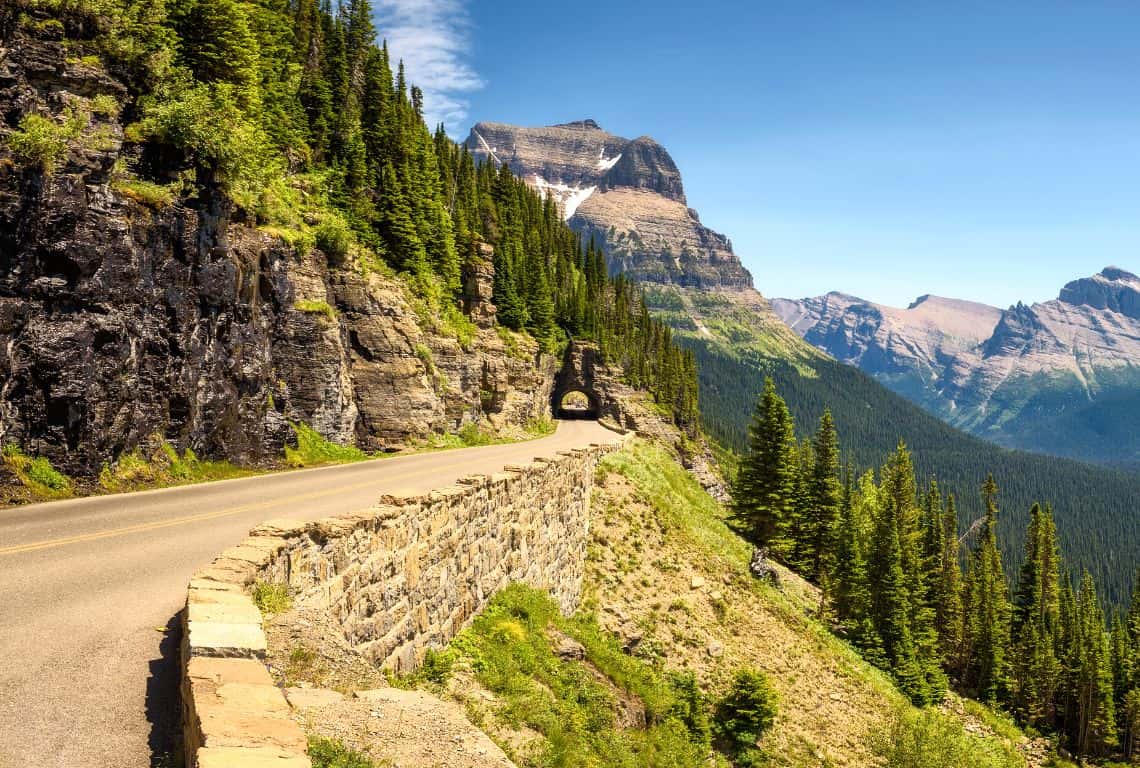
East Tunnel on Going-to-the-Sun Road / Best Stops on Going-to-the-Sun Road
Siyeh Bend and Siyeh Creek - Mile Marker 35
Siyeh Bend is another huge bend in the Going-to-the-Sun Road. It almost feels like you are making a U-turn on the road. This bend marks a transition between high-elevation alpine vegetation and the forests surrounding St. Mary Lake.
You will get to enjoy Siyeh Creek as it rushes down by the Going-to-the-Sun Road, plus the views of the surrounding peaks are stunning here.
GOOD TO KNOW: Two challenging yet popular hikes start at Siyeh Bend: Piegan Pass Trail and Siyeh Pass Trail.
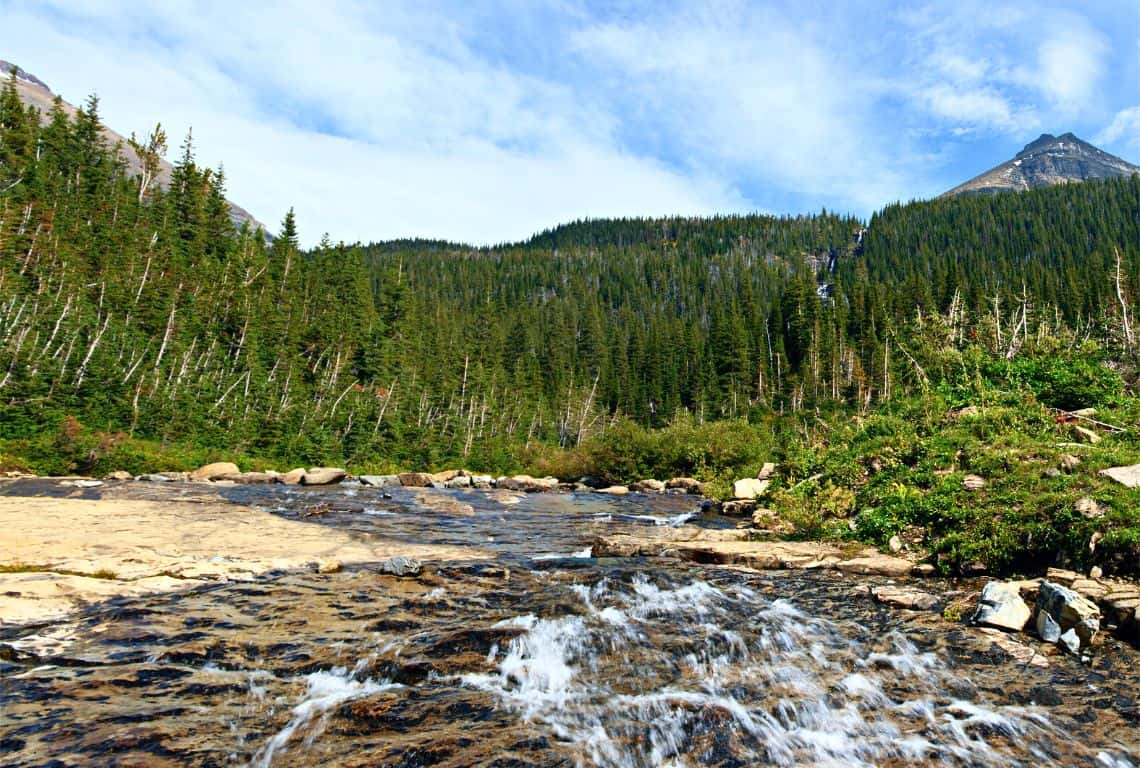
Siyeh Creek on Going-to-the-Sun Road / Best Stops on Going-to-the-Sun Road
Jackson Glacier Overlook - Mile Marker 38
Glacier National Park is home to 26 named glaciers. Jackson Glacier is the 7th largest glacier in the park.
Jackson Glacier is the only glacier that you will be able to see from the Going-to-the-Sun Road.
GOOD TO KNOW: There is an interpretative sign at the overlook that talks about climate change and the impact it has on the glaciers. In 1850 Jackson Glacier, along with the Blackfoot Glacier covered 1,875 acres. Since 2005, Jackson Glacier has shrunk to 250 acres.
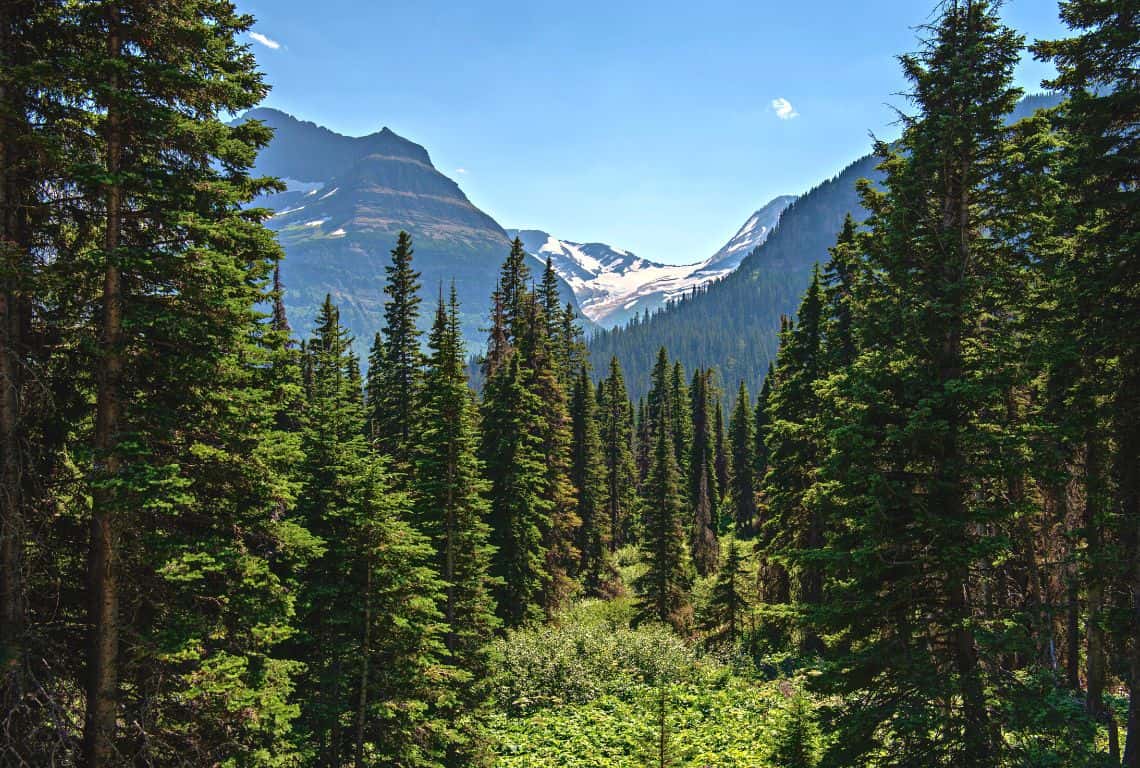
Jackson Glacier Overlook / Best Stops on Going-to-the-Sun Road
St. Mary Falls Trail - Mile Marker 39
St. Mary Falls Trail is one of the most popular hikes in Glacier National Park and this next stop is where the trailhead to this popular waterfall is located.
St. Mary Falls Trail is a short and easy hike (1.9 miles roundtrip and elevation change of 452 feet) and should be on your list of hikes to do in Glacier National Park.
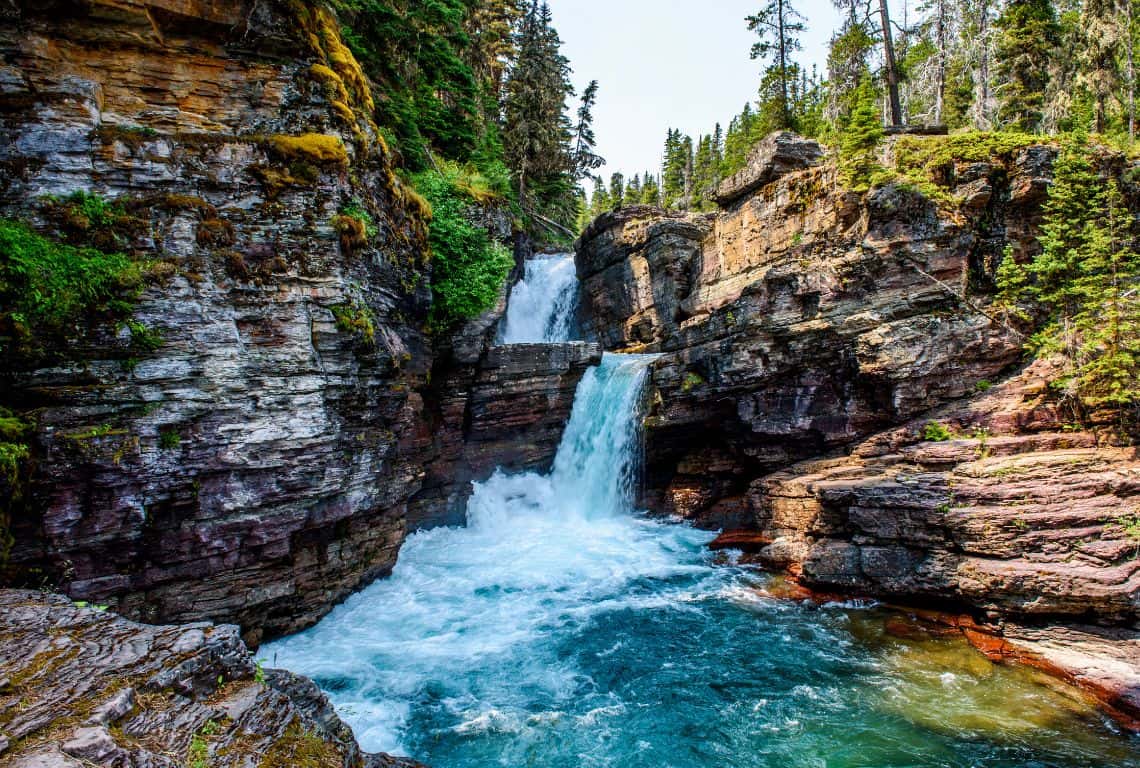
St. Mary Falls in Glacier National Park / Best Stops on Going-to-the-Sun Road
Once you reach St. Mary Falls, you can continue for another 0.8 miles to Virginia Falls, another beautiful waterfall.
INTREPID’S PRO TIP: What I like to do is to park just past St.Mary Falls Trailhead, at Sun Point and start hiking from Sun Point. You will start with the nature trail, then reach Baring Falls, next to St. Mary Falls, and finish off your hike at Virginia Falls. All in all, it is 6.5 miles roundtrip with an elevation change of 775 feet, however, it is worth the extra time and effort.
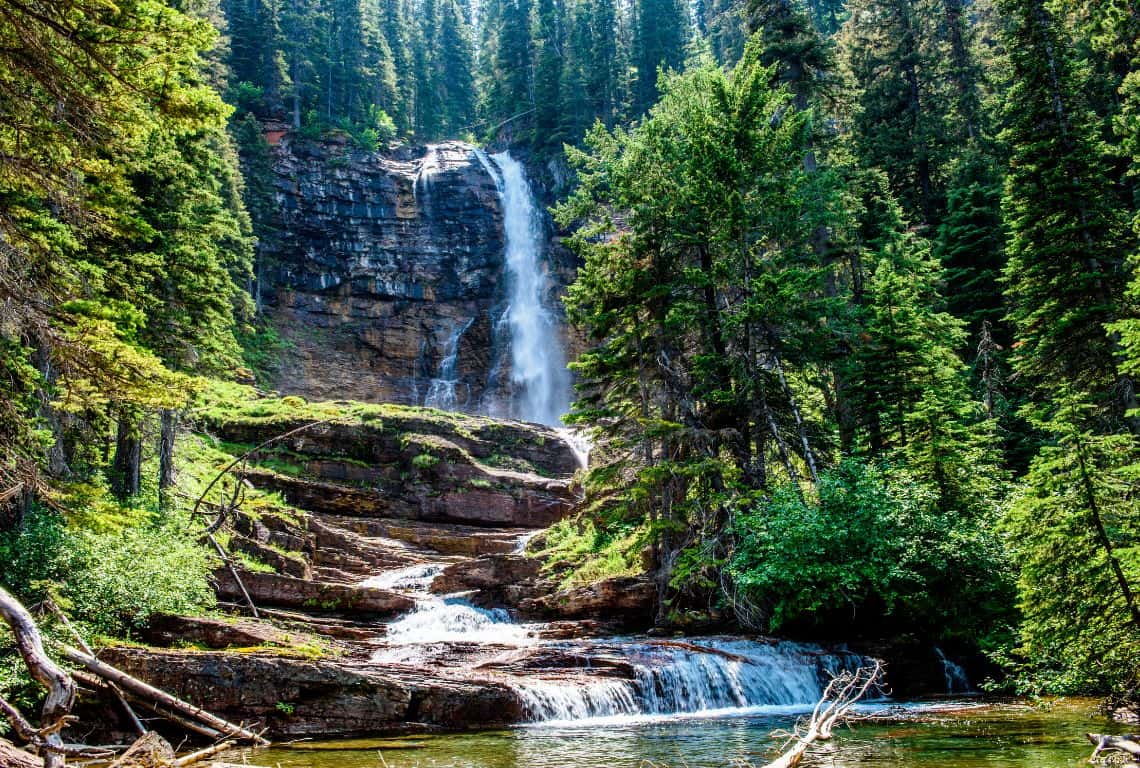
Virginia Falls in Glacier National Park / Best Stops on Going-to-the-Sun Road
Wild Goose Island Lookout - Mile Marker 43
Wild Goose Island is a tiny, yet very famous island, located right in the middle of St. Mary Lake. It was featured in the movie “The Shinning” and became an instant hit.
St. Mary Lake is surrounded by mountains, with Red Eagle Mountain being one of the most prominent ones, and with Wild Goose Island in the middle of the lake, it is an iconic view of Glacier National Park.
INTREPID’S PRO TIP: Sunsets are pretty spectacular from this viewpoint! So, if at all possible, make sure to come back here and catch a sunset.
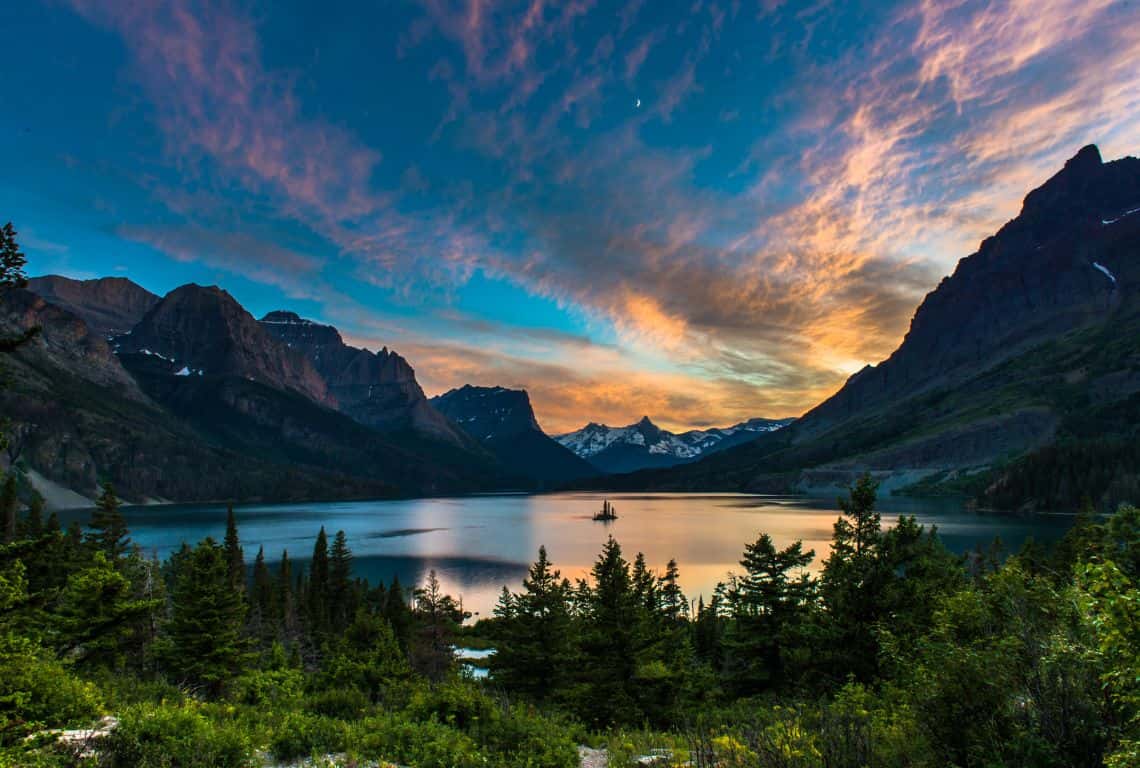
Wild Goose Island in Glacier National Park / Best Stops on Going-to-the-Sun Road
St. Mary Lake and St. Mary Visitor Center - Mile Marker 50
St. Mary Lake is a stunning lake. It is the second largest lake, after Lake McDonald, in Glacier National Park. It is a glacial finger lake at 9.9 miles long with a depth of 300 feet. It sits 1,500 feet higher than Lake McDonald at an elevation of 4,484 feet. In winter, St. Mary Lake is completely frozen up to 4 feet deep.
The views of the lake with Red Eagle Mountain in the distance are breathtaking!
Make sure to check out St. Mary Lake Visitor Center for some interesting exhibits, refuel your water bottles, and use the restrooms.
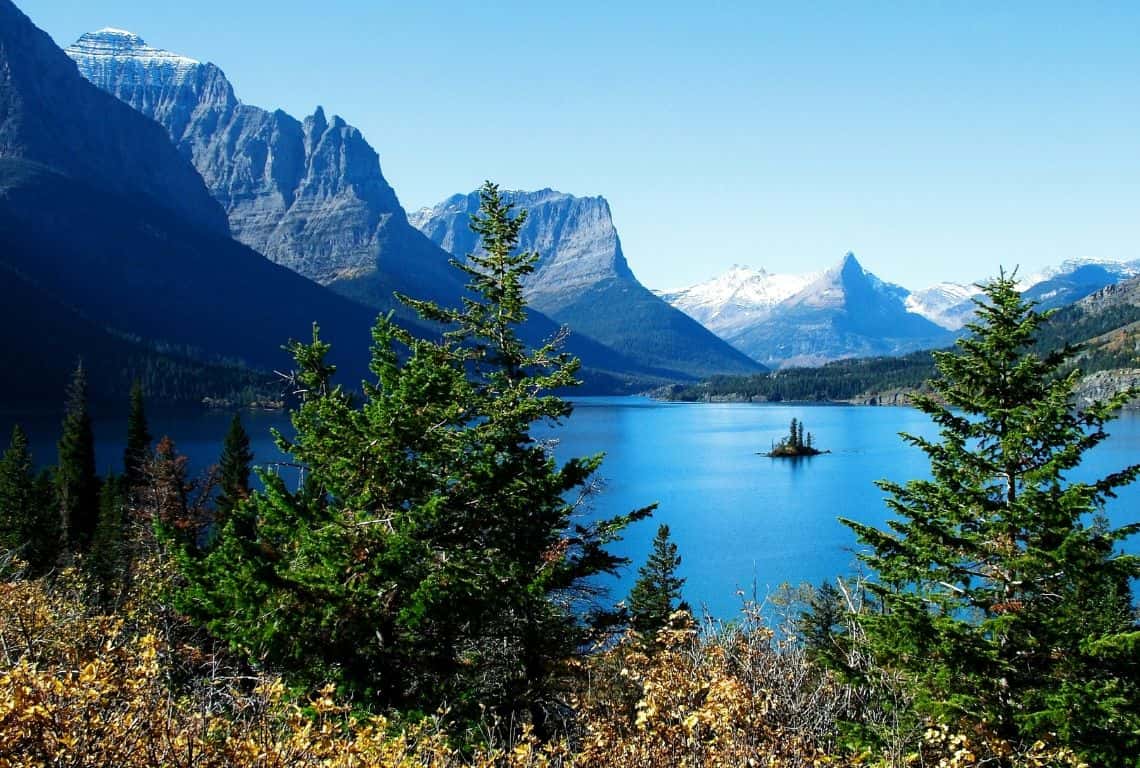
St. Mary Lake in Glacier National Park / Best Stops on Going-to-the-Sun Road
Intrepid Scout's Tips for Going-to-the-Sun Road in Glacier National Park
- Check for Road Conditions and Closures: Before heading out and venturing on the Going-to-the-Sun Road always check for road conditions and road closures. Check for updates here.
- Start Your Day Early: If you are using your vehicle to drive Going-to-the-Sun Road, then make sure to get started as early as possible. There are limited parking spots at each stop, viewpoint, or trailhead, and by 9-10 am you will either have to patiently wait for a spot or give up and drive away.
- Reserve at least 4-5 Hours: Make sure to set aside at least 4-5 hours to drive and make some stops on the Going-to-the-Sun Road. Be prepared for some traffic and a lack of parking spots along the way.
- Visit During the Week: If possible, plan on driving the Going-to-the-Sun Road during the week. Skip driving the road on the weekend.
- Pack Food and Water: There are no grocery or convenience stores, and there are no places to eat, so pack your food and bring plenty of water.
- Fill up on Gas: There is only one gas station located at West Glacier, so fill up your gas tank before you venture out.
- There Is No Cellular Service: Do not count on having cell service while inside the park. Make sure to download Google Maps, and make screenshots of your reservation tickets.
- Carry Bear Spray and Be Bear Aware: If you plan on hiking, then make sure to rent or buy and carry bear spray. While hiking, make noise, talk loudly, and clap your hands to let the bears know you are in the vicinity. If possible, do not hike alone and stick with a group of hikers.
- Above all, be safe! Always use the designated turnouts to pull over and take photos. Do not stop in the middle of the road. If you finish your drive late in the evening and end up driving in the darkness, be very cautious driving. Drive slow and be on the lookout for animals crossing the road or jumping on the road.
INTREPID’S PRO TIP: After you visit Glacier, I am sure you will be looking for some cool mountain captions and quotes for all your pictures. Make sure to check out my post: 371 Ultimate Mountain Captions and Quotes for All Your Mountain Pictures
More Helpful Posts About Glacier National Park
9 Most Scenic Hikes in Glacier National Park You Need to Explore
10 Best Places to Stay in Glacier National Park (West vs East Side)
9 Best Photography Locations in Glacier National Park (+Useful Photo Tips)
Perfect First Visit to Glacier National Park (8 Things to Know)
8 Fun and Easy Hikes in Glacier National Park (with Stunning Views)
Did You Find This Useful?
Why Not Save Best Stops on Going-to-the-Sun Road in Glacier to Your Pinterest Board!
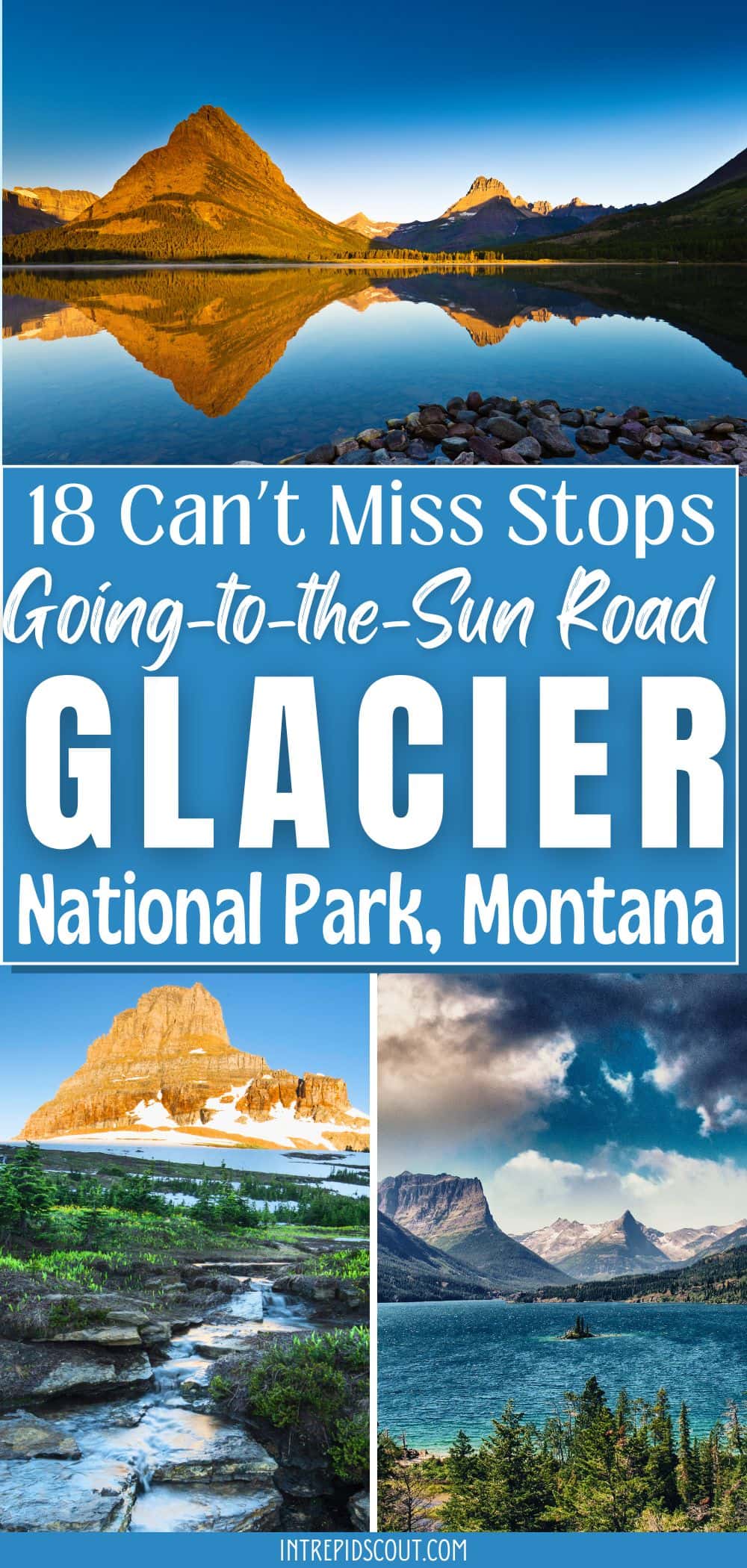
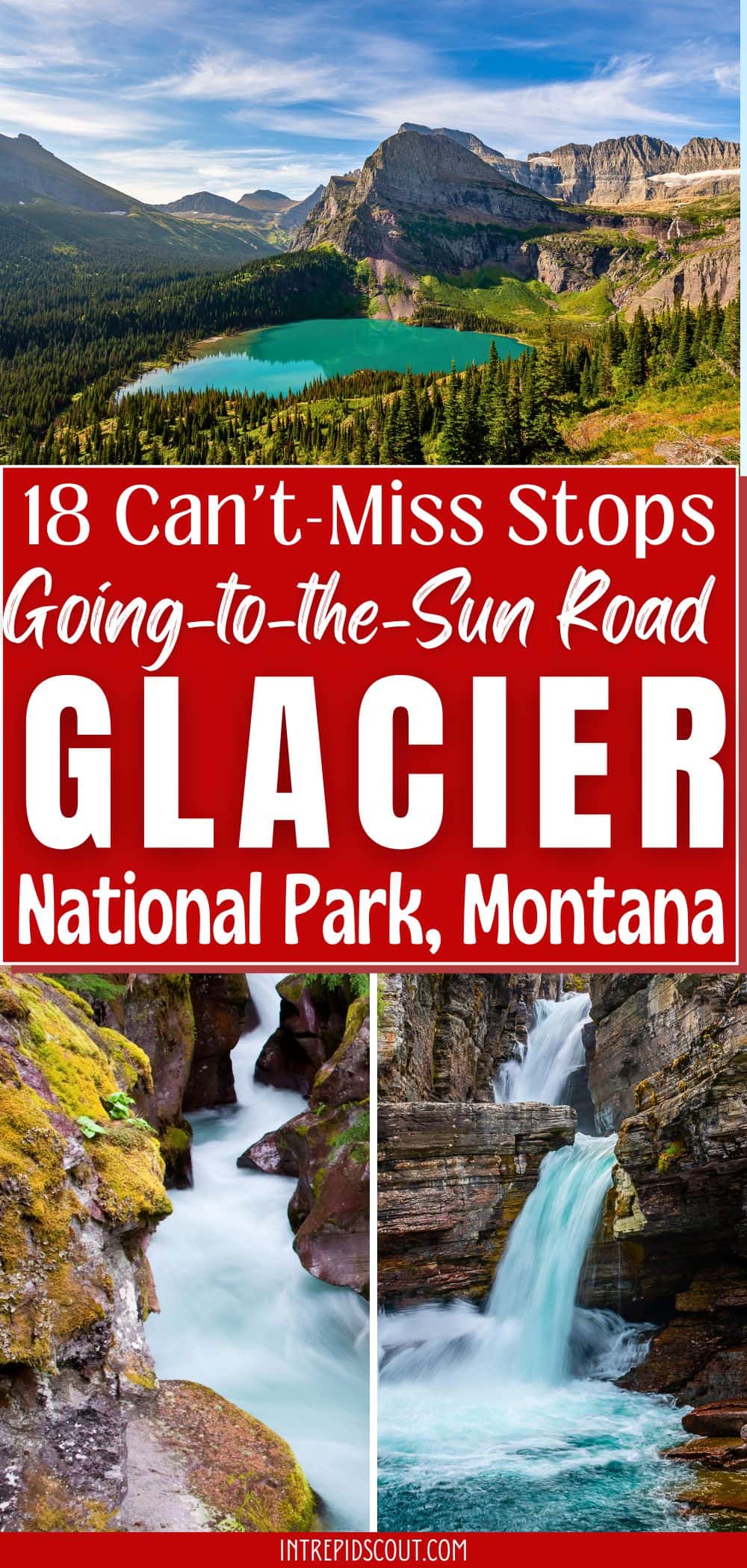
Now, It Is Your Turn, I Would Like to Hear Back from You!
Are you planning your trip to Glacier National Park?
Please let me know! Drop me a quick comment right below!
Click on any of the images below to get inspired and to help you with the planning process for your trip to Glacier National Park!
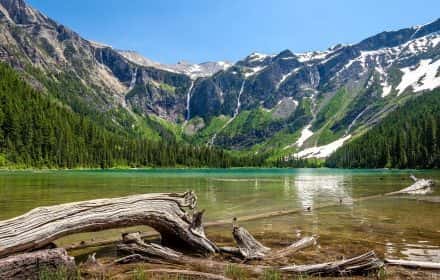
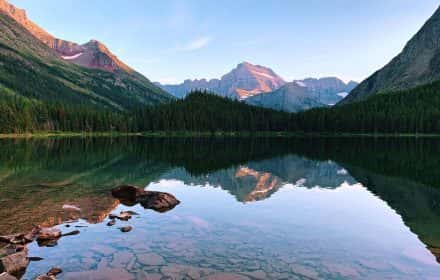
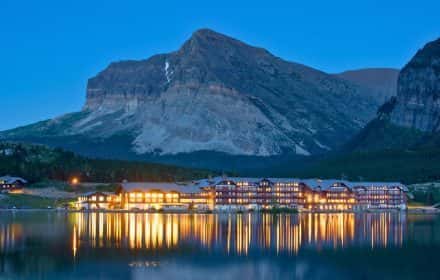
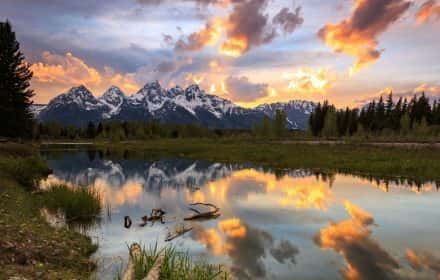
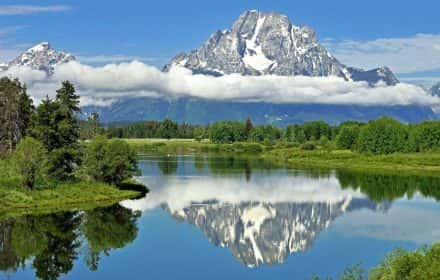
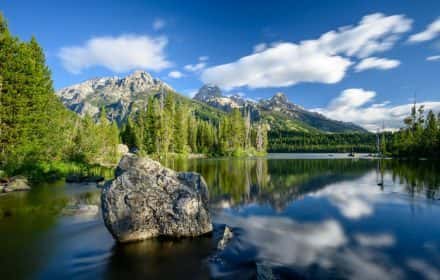
Comments:
2 thoughts on “18 Can’t Miss STOPS on GOING-TO-THE-SUN ROAD in Glacier National Park”
Planning our Glacier trip and this post was so helpful. Thanks!
Sandi, Thank You! You made my day!
Have a great time in Glacier.
Take care.